Guide to Research Methods
About the guide
This guide will
- Introduce you to a range of research methods
- Help you think about the value and limitations of different research methods
- Identify when to use alternative research methods
You should use the guide
- After or while you establish your research questions (See the Guide to Research Questions )
- When you are completing your Research Design Framework
- When you are thinking about who you want to talk to and why (See the Guide to Sampling )
You should print or read this guide
These slides are set up so that they can be printed back to back (two/four sided) to give:
- A short hand overview about when to use each method
- A summary of the method, what it’s good for and limitations (linking to other slides in this pack)
Choosing research methods
When you need to think about which method is best in theory and in practice
Choosing Research Methods
Providing a rationale for the methods you choose to use and how you employ them.
- What are your research goals? If you are looking to influence experts or policy makers, quantitative approaches will add weight to your findings. If you are looking to understand problems, inform innovation or develop a prototype, look at qualitative methods or user research
- What are your research questions? If they begin with ‘explore’ or ‘what’ look at qualitative methods (talking). If they begin with ‘identify’ or ‘why’ look at quantitative (see guide to research questions )
- What research traditions exist? You may choose to follow or challenge them. Think about whether you want your research to be noted for its quality and robustness or creative approach and unique insights
- What are your/your teams skills? You may not be an expert in the most appropriate method so consider asking for other team members or commissioning out research
- Who are you research participants? Think about your relationship to participants (especially if you are doing qualitative research) and how they will respond to you and the method. Consider if they are often consulted or surveyed and whether if could be helpful or unhelpful to stick with their comfort zone or not.
Using online tools
When you need to decide which tools to use for research
What to think about when choosing a tool to conduct research
- What’s the cost to the research quality ? Most tools are ‘freemium’, use a basic version for free. BUT these are designed to annoy you to pay to do good research. Consider privacy settings, data access, storage and value for money. Survey tools will have no option to filter participants (if yes/no answer this q), a 10Q limit, no branding. Mapping/visualisations are published online and open source tools aren’t always user friendly
- Start with user needs, understand the context and think about everyone. Consider what technology they have, how they will access the tool and what they need to do this. Do they have internet, data, time?
- Be creative: Online tools may not be designed for research, but Google Forms, Trello, Workflowy and Slack are all valuable collaboration tools. Twitter and Facebook polls may increase participation in research. However, think about what they are missing, what they can’t do and pilot your analysis approach first
- See what’s out there: This online sheet of Applied Social Research Guides and Resources includes a list of online tools for research and evaluation to test. Those widely used for your research method or sector are likely to be the best starting point. Some tools allow you to do research (see Tags for Twitter data capture), analyse it or present it in new ways (see Raw Graph s for data visualisation)
Contents: Methods summary
- Structured Interviews : When you want to gain a broad range of perspectives about specific questions
- Semi-Structured Interviews : When you want to gain in-depth insights about broad questions
- Unstructured Interviews : When you want to gain in-depth insights about a complex research topics
- Telephone Interviews : A tool for when you want to interview people quickly and easily
- Guerilla Interviews : When you want to carry out user research or explore general perspectives quickly
- Contextual Interviews : When you want to understand actions and particular experiences indepth and in context
- Focus Groups : When you want to understand shared experiences and different perspectives
- Participant Observation : When you want to ‘learn by doing’ or observe social interactions and behaviour
- Ethnography : When you want to experience social practices, interactions and behaviour with minimal influence
- Surveys: When you want to generate numerical data about the scale of people’s opinions and feelings
- Mixed Methods: When one method cannot fully answer your main research question
- User Research : When you want to learn about the behaviours and motivations of your target audience
- Service Design Research : When you want to design a service to meet people’s needs.
- Content Analysis : When you want to understand public discourse through secondary or online data
- Workshops : When you want to engage stakeholders in research, generate ideas or codesign solutions
- Usability tests : When you want to test prototypes or learn about problems with an existing service
Find out more
How to do good…
- Applied social research: A curated online sheet of Applied Social Research Guides and Resources
- Surveys : Guide to creating questions here and here , build on existing data/questions , analysis guide
- Interviews : A nice overview here which includes how to structure an interview
- User research : The GDS for intro guides and DisAmbiguity blog
- Service design: This is Service Design Doing has great tools and formats for workshops
Inspiration for emerging research methods and creative formats for research
- Ethnography and mixed methods presented well: Ikea At Home Report
- User mapping techniques as a social research method NPC Report
- User Research to understand domestic abuse experiences and the potential for technology Tech Vs Abuse
- Using Twitter data for social research Demos
- Data visualisation as a tool for research communication - Nesta data visualisation and Women’s Aid Map
- Data journalism and data storytelling - Guardian reading the riots
- An online games to shift perspective on a social problem - Financial Times Uber Story
- Content analysis to map trends - Nesta analysed creative skills in job adverts
- Issue mapping online - networks of websites and people on Twitter - Warwick University Issue Mapping
Structured Interviews
When you want to gain a broad range of perspectives about specific questions
Also consider
Semi-structured interviews
A conversation with a set structure (a script of fixed questions) and specific purpose. Can be a method to undertake a survey or called a ‘directed’ interview.
- Asking standardised questions across many participants makes data easier to analyse and compare
- Giving participants a clear guide about what you want to learn from them
- Topics that would be too complex to capture in a questionnaire tick box/short response
- Respondents with limited time, who want to consider responses in advance or do not want to write
- The quality of the interview is less dependent on the interviewer and their rapport with the interviewee
Limitations (and how to avoid or what to consider instead)
- The structure prevents participants from bringing in other ideas (consider semi-structured interviews )
- Whilst quicker to conduct and analyse than semi-structured interviews, they are still resource intensive and only possible to do with limited numbers of people (consider questionnaires online - see surveys )
Semi-Structured Interviews
When you want to gain in-depth insights about broad questions
Participant Observation
User research
Focus groups
Semi-Structured interviews
Conversation with a structure (set of open questions) and clear purpose. Also called directed interviews.
- Exploring a range of perspectives on research questions, engaging experts and getting buy-in to research
- Gaining in-depth insights about how people feel or interpret complex issues
- Topics which are sensitive, difficult to express in writing or to articulate views about in a survey
- Allowing participants to respond in their words, framing what they see as important
Limitations
- Quality can depend on interviewer skills and put people on the spot (consider setting topics in advance)
- The set-up affects the quality of engagement and discussion (consider location, relationship with the interviewee and whether you should do a face to face or Telephone/Online interview )
- Time consuming to do, analyse and compare (consider Structured Interviews or Focus groups )
- Can lack validity as evidence (consider Surveys )
- Explore what people say, think and remember, not what they actually do (consider Participant Observation contextual interviews or User Research ) or shared perspectives (consider Focus groups )
- Easy to provide too much structure and prevent open exploration of a topic (see unstructured interviews )
Unstructured Interviews
When you want to gain in-depth insights about a complex research topics
Contextual interviews
Unstructured interviews
A loosely structured open conversation guided by research topics (also called non-directed interviews)
- Very exploratory research and broad research questions
- Letting the participant guide the interview according to their priorities and views
- In-depth and broad discussion about a person's expertise, experiences and opinions
- Participant can feel like the they are not saying the ‘right’ thing (explain technique and rationale well)
- Whilst useful for expert interviews, an unstructured approach can give the impression that the interviewer is unprepared, lacks knowledge or the research purpose is unclear (consider semi-structured interviews )
- Interviews are longer, resource intensive and only smaller numbers are possible (consider focus groups )
- Generates in-depth insights that are difficult to analyse and compare
- A lack of structure can encourage participants to focus in-depth on one thing they are positive about or know very well in-depth (consider using desk research to inform the interview topics)
Guerilla Interviews
When you want to carry out user research or explore general perspectives quickly and easily
An ‘impromptu’ approach to interviewing, often talking to real people on the street or at a key site
- Gaining immediate responses to a tool or design and insights into a problem
- Informal method means participants can be more relaxed and open
- Speaking to a lot of people, simply, quickly and cheaply about one key question
- User research and user experience of interacting with digital products
- Speaking to people for convenience (users are available in a single place and time) introduces sample bias (but you can add more targeting and profiling of participants, see the Guide to Sampling )
- The lack of formal structure can mean that you miss important questions or insights
- Findings are often unreliable and not generalisable because they rely on a single type of user
- Difficult to understand complexity or gain contextual insights
Telephone / online interviews
A tool for when you want to interview people quickly and easily
Telephone or Online interviews
A tool to conduct an interview (it is not a method in itself) which is not in person/ face to face
- Conducting interviews without the costs of travel and meeting time (often shorter)
- Expert and stakeholder interviews, when you already know the participant well or they are short of time
- Taking notes and looking up information whilst interviewing is less disruptive than in person, easy to record
- Sending informed consent information and interview questions in advance
- Can be difficult to undertake an engaging interview (hard to build rapport on the phone)
- Often need to be shorter and put alongside other meetings
What method are you using?
- Structured interviews : When you want to gain a broad range of perspectives about specific questions
- Semi-structured interviews : When you want to gain in-depth insights about broad questions
- Unstructured interviews : When you want to gain in-depth insights about a complex research topics
Further guides to Interviews : A nice overview here , including how to structure an interview
Contextual Interview
When you want to understand actions and particular experiences in-depth and in context
Ethnography
Interviews conducted with people in a situational context relevant to the research question; also known as contextual inquiry.
- Understanding what happens, experiences and emotions whilst interacting with a tool, service or event.
- Easier for research participants to show rather than explain, participants are active and engaged
- Uncover what happens, what people do, how they behave in the moment, rather than how they remember this and give meaning to these responses later.
- Open and flexible method giving depth of insights about a tool or specific interaction
- Time and resource intensive for the researcher
- Each context is unique - making it difficult to generalise from or to answer broader research questions about experiences (consider semi-structured interviews )
- The researcher influences the interactions and events (consider ethnography or participant observation )
When you want to understand shared experiences and different perspectives
Focus Groups
An organised discussion with a group of participants, led by a facilitator around a few key topics
- Gaining several perspectives about the same topic quickly
- Research contexts and topics where familiarity between participants can generate discussion about similar experiences (or different ones) which may not arise in a one to one interview
- When attitudes, feelings and beliefs are more likely to be revealed in social gathering and interactions
- Including tasks and creative methods to elicit views (e.g. shared ranking of importance of statements)
- Difficult to identify the individual view from the group view (consider semi-structured interviews )
- Group dynamics will affect the conversation focus and participation levels of different members
- The role of the moderator is very significant. Good levels of group leadership and interpersonal skill are required to moderate a group successfully.
- The group set-up is an ‘artificial’ social setting and discussion (consider Participant Observation )
Participant observation
When you want to ‘learn by doing’ and observe social interactions and behaviour
Participant observation/ shadowing
The researcher immerses themselves in lives of participants as an ‘observer’ of their behaviours, practices and interactions. A type of ethnography. The people being observed know about the research.
- Understanding everyday behaviours, interactions and practice in the context that they occur
- Gaining an intuitive understanding of what happens in practice and what this means for those involved
- Allowing research participants to show you what they do, when they can’t describe and remember this well
- Establishing topics for further investigation through more structured or focused research methods
- If explicit (shadowing for example) the research situation is still ‘artificial’
- Your audience may not respect it and can be difficult to generalise from (consider mixed methods)
- The quality of the data is dependent on the researchers’ skills and relationships with participants
When you want to experience social practices, interactions and behaviour with minimal influence on what happens
The systematic study of a group of people or cultures to understand behaviours and interactions. The researcher becomes an ‘insider’. It is a way of presenting research findings, as well as a method, which can include participant observation, document analysis and visual methods.
- When you need to be an ‘insider’ to fully access the research context (such as organisational cultures)
- Presenting how everyday behaviours, interactions and practice occur in context
- Gaining an in-depth knowledge of your research context, participants and social relationships
- When little is known about a research context or topic
- If covert (at a conference or workplace for example) it has implications for informed consent
- If explicit (shadowing for example) the researcher’s presence can affect the interactions and findings
Example use case : Ikea At Home research study to understand how people feel about their home
When you want to generate numerical data about the scale of people’s opinions and feelings
Mixed Methods
A process of systematically collecting information from a large number of different people. Responses are summarised as statistics (online surveys automate this analysis for you).
- Targeting specific types of research participant and providing data about their views
- If designed well, they can be quick, simple and non intrusive for research participants
- Findings can have more credibility than other methods because of their breadth
- Describing, measuring and understanding (a basic questionnaire)
- Statistical analysis, modelling cause and effect (large scale survey designed to represent the population)
- Can raise more questions about what happens and why, lack depth of insight (consider mixed methods )
- Hard to design well and require a lot of time upfront and data skills to analyse the results
- Low completion rates and people feel ‘over surveyed’ (consider incentives )
- Assumes people will be honest and sufficiently aware of the research context to provide credible answers.
Further information: A great guide to creating questions here and here , build on existing data/questions here
When one research method cannot fully answer your main research question
Mixed methods
Combining different methods to answer your research questions, can be a mix of quantitative or qualitative methods or both. It may mean working with different types of data, research designs or being part of a research team (covering different research disciplines)
- Overcoming the limitation of relying on a single research method or approach
- Triangulating findings (i.e. using an additional method) can give them more validity
- Accessing different types of research participants
- A more holistic understanding about how, why and the extent to which something happens
- Answering different types of research questions about frequency and perceptions
- Giving findings more validity and influence because of the range of data and insights
- Requires a broader range of skills and more time to deliver, analyse and report on
- Research design must have strong sequencing (when each method is used and analysed , why) to make the most of a mixed methods approach - not always possible in a tight timescale or short research project
User Research
When you want to learn about people’s needs, behaviours and motivations for using a service
Service Design
S emi-Structured Interviews
Usability testing
A research approach employed to understand users and their needs, motivations and behaviours, primarily to inform service design.
- User-centered design processes which look to ensure services meet the needs of their audience
- Gaining specific insights into how a person interacts with a digital tool or service
- Exploring general needs, behaviours and motivations for a specific target group using a range of services
- Focus on a tool or service can prevent wider analysis, relevance and applicability
- Research can lack credibility due to small numbers, set up, documentation (often highly specific focus)
- Can overlook those who do not use a service for a whole range of reasons
What method?
- User research involves any method which looks at who users are, the problems they face, what they are trying to do and how they use existing services. This can create user personas, user journeys and user experience maps. It largely includes qualitative research methods.
When you want to design a service to meet people’s needs, including planning, organising, infrastructure, communication and components)
A research approach employed in the activity of planning and organising of people, infrastructure, communication and material components of a service, in order to improve quality and interaction.
- Gaining a holistic picture of all components (infrastructure, people, organisations, culture) affecting how a person interacts with a service
- Service design often begins with user research but participants in research include all those involved in delivering (not just using) a service, such as employees and stakeholders in an organisation as well as looking at the context and system which affect how a service works and its effectiveness
Content analysis
When you want to understand public discourse through secondary or online data
A systematic process of classifying and interpreting documents, text or images to analyse key discourses (their meaning) or to quantify patterns (such as word frequencies). This can be done manually or it can be automated.
- Exploring the focus of messages, text or imagery and change over time
- Secondary data sources, such as archives, online social media data (such as Tweets) and news articles
- Gaining a qualitative or quantitative insights about key messages
- Focuses on public and documented interpretations of events and experiences
- Documents are not exhaustive and not all are accessible (or available online/freely)
- Qualitative coding is time intensive to manually classify, reliant on researcher interpretation
- Automated coding for key words can miss nuances and difficult to produce meaningful findings
When you want to engage stakeholders in research, generate ideas or codesign solutions
Also consider:
A tool to undertake research. It is an interactive session, often taking a full day, in which research participants sor stakeholders work intensively on an issue or question. The process can combine elements of qualitative research, brainstorming or problem solving.
- Engaging stakeholders - building empathy with and understanding of research findings
- Understanding problems or prototyping solutions, linked to user research and service design approaches
- Participatory research, allowing participants to shape agendas and outcomes
- Creative, collaborative and engaging activities to build rapport and understanding with participants
- Participatory design, enabling participants to co-design solutions which work for them
- Highly dependent on the right people attending and the facilitation skills
- Can be a lot of time and effort to coordinate a workshop effectively and analyse findings
- The immersive and collaborative environment makes it difficult to document effectively
- Collaborative solutions may duplicate existing problems or solutions
When you want to test prototypes or learn about problems with an existing service
A user research method where you watch participants try to complete specific tasks using your service. Moderated testing involve interaction with the research participant, asking them to explain what they are doing, thinking and feeling. Unmoderated testing is completed alone by the participant.
- Identify any usability issues with a digital service - for example, problems with the language or layout
- Seeing if users understand what they need to do in order to complete designated tasks
- Generating ideas to improve a prototype of existing digital service
- Assessing user experience
- Focus is not on ‘natural’ use (consider contextual interviews , participant observation , ethnography )
- Data is about a specific design and interaction with a tool at that moment
- Findings cannot be generalised or applicable more broadly to understand users and behaviours

- My presentations

Auth with social network:
Download presentation
We think you have liked this presentation. If you wish to download it, please recommend it to your friends in any social system. Share buttons are a little bit lower. Thank you!
Presentation is loading. Please wait.
Lecture Notes on Research Methodology
Published by Eileen Garrison Modified over 6 years ago
Similar presentations
Presentation on theme: "Lecture Notes on Research Methodology"— Presentation transcript:

Introduction to Research Methodology

Sabine Mendes Lima Moura Issues in Research Methodology PUC – November 2014.

Today Concepts underlying inferential statistics

Richard M. Jacobs, OSA, Ph.D.

Research Methodology Lecture 1.

Chapter 12 Inferential Statistics Gay, Mills, and Airasian

Sample Design.

Copyright © 2008 by Pearson Education, Inc. Upper Saddle River, New Jersey All rights reserved. John W. Creswell Educational Research: Planning,

Magister of Electrical Engineering Udayana University September 2011

Chapter 1: Introduction to Statistics

RESEARCH A systematic quest for undiscovered truth A way of thinking

Research Methodology.

Educational Research: Competencies for Analysis and Application, 9 th edition. Gay, Mills, & Airasian © 2009 Pearson Education, Inc. All rights reserved.

Research Seminars in IT in Education (MIT6003) Quantitative Educational Research Design 2 Dr Jacky Pow.

PROCESSING OF DATA The collected data in research is processed and analyzed to come to some conclusions or to verify the hypothesis made. Processing of.

Academic Research Academic Research Dr Kishor Bhanushali M

Question paper 1997.

Chapter 6: Analyzing and Interpreting Quantitative Data

Module III Multivariate Analysis Techniques- Framework, Factor Analysis, Cluster Analysis and Conjoint Analysis Research Report.

Chapter 7 Measuring of data Reliability of measuring instruments The reliability* of instrument is the consistency with which it measures the target attribute.
About project
© 2024 SlidePlayer.com Inc. All rights reserved.
Academia.edu no longer supports Internet Explorer.
To browse Academia.edu and the wider internet faster and more securely, please take a few seconds to upgrade your browser .
Enter the email address you signed up with and we'll email you a reset link.
- We're Hiring!
- Help Center

A COURSE IN RESEARCH METHODOLOGY 2018.pptx

This teaching paper is an introdcution to the field of research methodology as it enables beginners (students) to understand basic things about research, research techniques , research design and research procedure. The general aim behind this teaching paper is to facilitate the task of students to tackle this complicated field with confidence and ease.It covers a lot of courses and it can be taught to different levels of students: BA, MA and even PHd students.
Related Papers
Wafae Barkani
Xochitl Ortiz
The authors felt during their several years of teaching experience that students fail to understand the books written on Research Methodology because generally they are written in technical language. Since this course is not taught before the Master’s degree, the students are not familiar with its vocabulary, methodology and course contents. The authors have made an attempt to write it in very non- technical language. It has been attempted that students who try to understand the research methodology through self-learning may also find it easy. The chapters are written with that approach. Even those students who intend to attain high level of knowledge of the research methodology in social sciences will find this book very helpful in understanding the basic concepts before they read any book on research methodology. This book is useful those students who offer the Research Methodology at Post Graduation and M.Phil. Level. This book is also very useful for Ph.D. Course Work examinations.
Anil Jharotia
Research is an important activity of any nation and societies for generating the information to its developments. Robust collection of qualitative information helps in the development of the any nations. Research & Development is an important tool for acquiring new knowledge in any field of human survival. Various type of problems and questions need to use research methodology depend on the rationale of researchers. How to use the research for finding answers of any research questions/problems.
https://www.ijrrjournal.com/IJRR_Vol.6_Issue.3_March2019/Abstract_IJRR0011.html
International Journal of Research & Review (IJRR)
Research methodology is a way to systematically solve the research problem. It may be understood as a science of studying how research is done scientifically. In it we study the various steps that are generally adopted by a researcher in studying his research problem along with the logic behind them. It is necessary for the researcher to know not only the research methods/techniques but also the methodology. Researchers not only need to know how to develop certain indices or tests, how to calculate the mean, the mode, the median or the standard deviation or chi-square, how to apply particular research techniques, but they also need to know which of these methods or techniques, are relevant and which are not, and what would they mean and indicate and why. Researchers also need to understand the assumptions underlying various techniques and they need to know the criteria by which they can decide that certain techniques and procedures will be applicable to certain problems and others will not. All this means that it is necessary for the researcher to design his methodology for his problem as the same may differ from problem to problem.
Scholarly Communication and the Publish or Perish Pressures of Academia A volume in the Advances in Knowledge Acquisition, Transfer, and Management (AKATM) Book Series
Dr. Naresh A . Babariya , Alka V. Gohel
The most important of research methodology in research study it is necessary for a researcher to design a methodology for the problem chosen and systematically solves the problem. Formulation of the research problem is to decide on a broad subject area on which has thorough knowledge and second important responsibility in research is to compare findings, it is literature review plays an extremely important role. The literature review is part of the research process and makes a valuable contribution to almost every operational step. A good research design provides information concerning with the selection of the sample population treatments and controls to be imposed and research work cannot be undertaken without sampling. Collecting the data and create data structure as organizing the data, analyzing the data help of different statistical method, summarizing the analysis, and using these results for making judgments, decisions and predictions. Keywords: Research Problem, Economical Plan, Developing Ideas, Research Strategy, Sampling Design, Theoretical Procedures, Experimental Studies, Numerical Schemes, Statistical Techniques.
Hafizi Saari
Dr. Moses Gweyi
This book is the outcome of more than four decades of experience of the author in teaching and research field. Research is a creative process and the topic of research methodology is complex and varied. The basic premise for writing this book is that research methods can be taught and learnt. The emphasis is on developing a research outlook and a frame of mind for carrying out research. The book presents current methodological techniques used in interdisciplinary research along with illustrated and worked out examples. This book is well equipped with fundamentals of research and research designs. All efforts have been made to present Research, its meaning, intention and usefulness. Focussed in designing of research programme, selection of variables, collection of data and their analysis to interpret the data are discussed extensively. Statistical tools are complemented with examples, making the complicated subject like statistics simplest usable form. The importance of software, like MS Excel, SPSS, for statistical analyses is included. Written in a simple language, it covers all aspects of management of data with details of statistical tools required for analysis in a research work. Complete with a glossary of key terms and guides to further reading, this book is an essential text for anyone coming to research for the first time and is widely relevant across the disciplines of sciences. This book is designed to introduce Masters, and doctoral students to the process of conducting scientific research in the life sciences, social sciences, education, public health, and related scientific disciplines. It conforms to the core syllabus of many universities and institutes. The target audience for this book includes those are going to start research as graduate students, junior researchers, and professors teaching courses on research methods. The book entitled “A guide to Research Methodology for Beginners” is succinct and compact by design focusing only on essential concepts rather than burden students with a voluminous text on top of their assigned readings. The book is structured into the following nine chapters. Chapter-1: What is Scientific Research? Chapter-2: Literature Review Chapter-3: How to develop a Research Questions & Hypotheses Chapter-4: Research Methods and the Research Design Chapter-5: Concept of Variables, Levels and Scales of Measurements for Data collection Chapter-6: Data Analysis, Management and Presentation Chapter-7: Tips for Writing Research Report Chapter-8: Glossary Related to Research Methodology Chapter-9: References It is a comprehensive and compact source for basic concepts in research and can serve as a stand-alone text or as a supplement to research readings in any doctoral seminar or research methods class. The target audience for this book includes those are going to start research as graduate students, junior researchers, and professors teaching courses on research methods.
Yuanita Damayanti
Khamis S Moh'd
Loading Preview
Sorry, preview is currently unavailable. You can download the paper by clicking the button above.
RELATED PAPERS
Linear Algebra and its Applications
Kresimir Veselic
International …
Tanit G Sanchez
Dida Novandika
Tunzala Verdiyeva
Jurnal Ketenagakerjaan
sapto setyodhono
Biochemical Journal
Krishna Persaud
ENGLISH IN AFRICA
Danson Kahyana
Revista Brasileira de Reumatologia
TANIA CAMILA DIAZ CASTRO
Fibrogenesis & Tissue Repair
I. Mannaerts
Investigación en Educación Médica
Delia Aguirre
Journal of cancer prevention
Engin Yenice
Desenvolvimento e Meio Ambiente
Edward H. Allison
Physica Medica
Ria Bogaerts
AIChE Journal
Juan carlos Rivarola
Diabetology & Metabolic Syndrome
Amal Baalash
Van Stekelenburg, Jacquelien, Bert Klandermans, and Agnes Akkerman. "Does civic participation stimulate political activity?." Journal of Social Issues 72, no. 2 (2016): 286-314.
Jacquelien van Stekelenburg
yekti nugroho
Antioxidants
Grazia Luisi
Bulletin of the American Physical Society
Innocent Mutabazi
Families in Society: The Journal of Contemporary Social Services
Lisa Dumain
Dialog. Pismo Dialogu Społecznego
Ngọc Nguyễn Thị
Johan Maritz
IEEE Access
Miguel Angel Sanchez-Soriano
RELATED TOPICS
- We're Hiring!
- Help Center
- Find new research papers in:
- Health Sciences
- Earth Sciences
- Cognitive Science
- Mathematics
- Computer Science
- Academia ©2024

Chapter 20. Presentations
Introduction.
If a tree falls in a forest, and no one is around to hear it, does it make a sound? If a qualitative study is conducted, but it is not presented (in words or text), did it really happen? Perhaps not. Findings from qualitative research are inextricably tied up with the way those findings are presented. These presentations do not always need to be in writing, but they need to happen. Think of ethnographies, for example, and their thick descriptions of a particular culture. Witnessing a culture, taking fieldnotes, talking to people—none of those things in and of themselves convey the culture. Or think about an interview-based phenomenological study. Boxes of interview transcripts might be interesting to read through, but they are not a completed study without the intervention of hours of analysis and careful selection of exemplary quotes to illustrate key themes and final arguments and theories. And unlike much quantitative research in the social sciences, where the final write-up neatly reports the results of analyses, the way the “write-up” happens is an integral part of the analysis in qualitative research. Once again, we come back to the messiness and stubborn unlinearity of qualitative research. From the very beginning, when designing the study, imagining the form of its ultimate presentation is helpful.
Because qualitative researchers are motivated by understanding and conveying meaning, effective communication is not only an essential skill but a fundamental facet of the entire research project. Ethnographers must be able to convey a certain sense of verisimilitude, the appearance of true reality. Those employing interviews must faithfully depict the key meanings of the people they interviewed in a way that rings true to those people, even if the end result surprises them. And all researchers must strive for clarity in their publications so that various audiences can understand what was found and why it is important. This chapter will address how to organize various kinds of presentations for different audiences so that your results can be appreciated and understood.
In the world of academic science, social or otherwise, the primary audience for a study’s results is usually the academic community, and the primary venue for communicating to this audience is the academic journal. Journal articles are typically fifteen to thirty pages in length (8,000 to 12,000 words). Although qualitative researchers often write and publish journal articles—indeed, there are several journals dedicated entirely to qualitative research [1] —the best writing by qualitative researchers often shows up in books. This is because books, running from 80,000 to 150,000 words in length, allow the researcher to develop the material fully. You have probably read some of these in various courses you have taken, not realizing what they are. I have used examples of such books throughout this text, beginning with the three profiles in the introductory chapter. In some instances, the chapters in these books began as articles in academic journals (another indication that the journal article format somewhat limits what can be said about the study overall).
While the article and the book are “final” products of qualitative research, there are actually a few other presentation formats that are used along the way. At the very beginning of a research study, it is often important to have a written research proposal not just to clarify to yourself what you will be doing and when but also to justify your research to an outside agency, such as an institutional review board (IRB; see chapter 12), or to a potential funder, which might be your home institution, a government funder (such as the National Science Foundation, or NSF), or a private foundation (such as the Gates Foundation). As you get your research underway, opportunities will arise to present preliminary findings to audiences, usually through presentations at academic conferences. These presentations can provide important feedback as you complete your analyses. Finally, if you are completing a degree and looking to find an academic job, you will be asked to provide a “job talk,” usually about your research. These job talks are similar to conference presentations but can run significantly longer.
All the presentations mentioned so far are (mostly) for academic audiences. But qualitative research is also unique in that many of its practitioners don’t want to confine their presentation only to other academics. Qualitative researchers who study particular contexts or cultures might want to report back to the people and places they observed. Those working in the critical tradition might want to raise awareness of a particular issue to as large an audience as possible. Many others simply want everyday, nonacademic people to read their work, because they think it is interesting and important. To reach a wide audience, the final product can look like almost anything—it can be a poem, a blog, a podcast, even a science fiction short story. And if you are very lucky, it can even be a national or international bestseller.
In this chapter, we are going to stick with the more basic quotidian presentations—the academic paper / research proposal, the conference slideshow presentation / job talk, and the conference poster. We’ll also spend a bit of time on incorporating universal design into your presentations and how to create some especially attractive and impactful visual displays.
Researcher Note
What is the best piece of advice you’ve ever been given about conducting qualitative research?
The best advice I’ve received came from my adviser, Alford Young Jr. He told me to find the “Jessi Streib” answer to my research question, not the “Pierre Bourdieu” answer to my research question. In other words, don’t just say how a famous theorist would answer your question; say something original, something coming from you.
—Jessi Streib, author of The Power of the Past and Privilege Lost
Writing about Your Research
The journal article and the research proposal.
Although the research proposal is written before you have actually done your research and the article is written after all data collection and analysis is complete, there are actually many similarities between the two in terms of organization and purpose. The final article will (probably—depends on how much the research question and focus have shifted during the research itself) incorporate a great deal of what was included in a preliminary research proposal. The average lengths of both a proposal and an article are quite similar, with the “front sections” of the article abbreviated to make space for the findings, discussion of findings, and conclusion.
Figure 20.1 shows one model for what to include in an article or research proposal, comparing the elements of each with a default word count for each section. Please note that you will want to follow whatever specific guidelines you have been provided by the venue you are submitting the article/proposal to: the IRB, the NSF, the Journal of Qualitative Research . In fact, I encourage you to adapt the default model as needed by swapping out expected word counts for each section and adding or varying the sections to match expectations for your particular publication venue. [2]
You will notice a few things about the default model guidelines. First, while half of the proposal is spent discussing the research design, this section is shortened (but still included) for the article. There are a few elements that only show up in the proposal (e.g., the limitations section is in the introductory section here—it will be more fully developed in the conclusory section in the article). Obviously, you don’t have findings in the proposal, so this is an entirely new section for the article. Note that the article does not include a data management plan or a timeline—two aspects that most proposals require.
It might be helpful to find and maintain examples of successfully written sections that you can use as models for your own writing. I have included a few of these throughout the textbook and have included a few more at the end of this chapter.
Make an Argument
Some qualitative researchers, particularly those engaged in deep ethnographic research, focus their attention primarily if not exclusively on describing the data. They might even eschew the notion that they should make an “argument” about the data, preferring instead to use thick descriptions to convey interpretations. Bracketing the contrast between interpretation and argument for the moment, most readers will expect you to provide an argument about your data, and this argument will be in answer to whatever research question you eventually articulate (remember, research questions are allowed to shift as you get further into data collection and analysis). It can be frustrating to read a well-developed study with clear and elegant descriptions and no argument. The argument is the point of the research, and if you do not have one, 99 percent of the time, you are not finished with your analysis. Calarco ( 2020 ) suggests you imagine a pyramid, with all of your data forming the basis and all of your findings forming the middle section; the top/point of the pyramid is your argument, “what the patterns in your data tell us about how the world works or ought to work” ( 181 ).
The academic community to which you belong will be looking for an argument that relates to or develops theory. This is the theoretical generalizability promise of qualitative research. An academic audience will want to know how your findings relate to previous findings, theories, and concepts (the literature review; see chapter 9). It is thus vitally important that you go back to your literature review (or develop a new one) and draw those connections in your discussion and/or conclusion. When writing to other audiences, you will still want an argument, although it may not be written as a theoretical one. What do I mean by that? Even if you are not referring to previous literature or developing new theories or adapting older ones, a simple description of your findings is like dumping a lot of leaves in the lap of your audience. They still deserve to know about the shape of the forest. Maybe provide them a road map through it. Do this by telling a clear and cogent story about the data. What is the primary theme, and why is it important? What is the point of your research? [3]
A beautifully written piece of research based on participant observation [and/or] interviews brings people to life, and helps the reader understand the challenges people face. You are trying to use vivid, detailed and compelling words to help the reader really understand the lives of the people you studied. And you are trying to connect the lived experiences of these people to a broader conceptual point—so that the reader can understand why it matters. ( Lareau 2021:259 )
Do not hide your argument. Make it the focal point of your introductory section, and repeat it as often as needed to ensure the reader remembers it. I am always impressed when I see researchers do this well (see, e.g., Zelizer 1996 ).
Here are a few other suggestions for writing your article: Be brief. Do not overwhelm the reader with too many words; make every word count. Academics are particularly prone to “overwriting” as a way of demonstrating proficiency. Don’t. When writing your methods section, think about it as a “recipe for your work” that allows other researchers to replicate if they so wish ( Calarco 2020:186 ). Convey all the necessary information clearly, succinctly, and accurately. No more, no less. [4] Do not try to write from “beginning to end” in that order. Certain sections, like the introductory section, may be the last ones you write. I find the methods section the easiest, so I often begin there. Calarco ( 2020 ) begins with an outline of the analysis and results section and then works backward from there to outline the contribution she is making, then the full introduction that serves as a road map for the writing of all sections. She leaves the abstract for the very end. Find what order best works for you.
Presenting at Conferences and Job Talks
Students and faculty are primarily called upon to publicly present their research in two distinct contexts—the academic conference and the “job talk.” By convention, conference presentations usually run about fifteen minutes and, at least in sociology and other social sciences, rely primarily on the use of a slideshow (PowerPoint Presentation or PPT) presentation. You are usually one of three or four presenters scheduled on the same “panel,” so it is an important point of etiquette to ensure that your presentation falls within the allotted time and does not crowd into that of the other presenters. Job talks, on the other hand, conventionally require a forty- to forty-five-minute presentation with a fifteen- to twenty-minute question and answer (Q&A) session following it. You are the only person presenting, so if you run over your allotted time, it means less time for the Q&A, which can disturb some audience members who have been waiting for a chance to ask you something. It is sometimes possible to incorporate questions during your presentation, which allows you to take the entire hour, but you might end up shorting your presentation this way if the questions are numerous. It’s best for beginners to stick to the “ask me at the end” format (unless there is a simple clarifying question that can easily be addressed and makes the presentation run more smoothly, as in the case where you simply forgot to include information on the number of interviews you conducted).
For slideshows, you should allot two or even three minutes for each slide, never less than one minute. And those slides should be clear, concise, and limited. Most of what you say should not be on those slides at all. The slides are simply the main points or a clear image of what you are speaking about. Include bulleted points (words, short phrases), not full sentences. The exception is illustrative quotations from transcripts or fieldnotes. In those cases, keep to one illustrative quote per slide, and if it is long, bold or otherwise, highlight the words or passages that are most important for the audience to notice. [5]
Figure 20.2 provides a possible model for sections to include in either a conference presentation or a job talk, with approximate times and approximate numbers of slides. Note the importance (in amount of time spent) of both the research design and the findings/results sections, both of which have been helpfully starred for you. Although you don’t want to short any of the sections, these two sections are the heart of your presentation.
Fig 20.2. Suggested Slideshow Times and Number of Slides
Should you write out your script to read along with your presentation? I have seen this work well, as it prevents presenters from straying off topic and keeps them to the time allotted. On the other hand, these presentations can seem stiff and wooden. Personally, although I have a general script in advance, I like to speak a little more informally and engagingly with each slide, sometimes making connections with previous panelists if I am at a conference. This means I have to pay attention to the time, and I sometimes end up breezing through one section more quickly than I would like. Whatever approach you take, practice in advance. Many times. With an audience. Ask for feedback, and pay attention to any presentation issues that arise (e.g., Do you speak too fast? Are you hard to hear? Do you stumble over a particular word or name?).
Even though there are rules and guidelines for what to include, you will still want to make your presentation as engaging as possible in the little amount of time you have. Calarco ( 2020:274 ) recommends trying one of three story structures to frame your presentation: (1) the uncertain explanation , where you introduce a phenomenon that has not yet been fully explained and then describe how your research is tackling this; (2) the uncertain outcome , where you introduce a phenomenon where the consequences have been unclear and then you reveal those consequences with your research; and (3) the evocative example , where you start with some interesting example from your research (a quote from the interview transcripts, for example) or the real world and then explain how that example illustrates the larger patterns you found in your research. Notice that each of these is a framing story. Framing stories are essential regardless of format!
A Word on Universal Design
Please consider accessibility issues during your presentation, and incorporate elements of universal design into your slideshow. The basic idea behind universal design in presentations is that to the greatest extent possible, all people should be able to view, hear, or otherwise take in your presentation without needing special individual adaptations. If you can make your presentation accessible to people with visual impairment or hearing loss, why not do so? For example, one in twelve men is color-blind, unable to differentiate between certain colors, red/green being the most common problem. So if you design a graphic that relies on red and green bars, some of your audience members may not be able to properly identify which bar means what. Simple contrasts of black and white are much more likely to be visible to all members of your audience. There are many other elements of good universal design, but the basic foundation of all of them is that you consider how to make your presentation as accessible as possible at the outset. For example, include captions whenever possible, both as descriptions on slides and as images on slides and for any audio or video clips you are including; keep font sizes large enough to read from the back of the room; and face the audience when you are.
Poster Design
Undergraduate students who present at conferences are often encouraged to present at “poster sessions.” This usually means setting up a poster version of your research in a large hall or convention space at a set period of time—ninety minutes is common. Your poster will be one of dozens, and conference-goers will wander through the space, stopping intermittently at posters that attract them. Those who stop by might ask you questions about your research, and you are expected to be able to talk intelligently for two or three minutes. It’s a fairly easy way to practice presenting at conferences, which is why so many organizations hold these special poster sessions.

A good poster design will be immediately attractive to passersby and clearly and succinctly describe your research methods, findings, and conclusions. Some students have simply shrunk down their research papers to manageable sizes and then pasted them on a poster, all twelve to fifteen pages of them. Don’t do that! Here are some better suggestions: State the main conclusion of your research in large bold print at the top of your poster, on brightly colored (contrasting) paper, and paste in a QR code that links to your full paper online ( Calarco 2020:280 ). Use the rest of the poster board to provide a couple of highlights and details of the study. For an interview-based study, for example, you will want to put in some details about your sample (including number of interviews) and setting and then perhaps one or two key quotes, also distinguished by contrasting color background.
Incorporating Visual Design in Your Presentations
In addition to ensuring that your presentation is accessible to as large an audience as possible, you also want to think about how to display your data in general, particularly how to use charts and graphs and figures. [6] The first piece of advice is, use them! As the saying goes, a picture is worth a thousand words. If you can cut to the chase with a visually stunning display, do so. But there are visual displays that are stunning, and then there are the tired, hard-to-see visual displays that predominate at conferences. You can do better than most presenters by simply paying attention here and committing yourself to a good design. As with model section passages, keep a file of visual displays that work as models for your own presentations. Find a good guidebook to presenting data effectively (Evergreen 2018 , 2019 ; Schwabisch 2021) , and refer to it often.
Let me make a few suggestions here to get you started. First, test every visual display on a friend or colleague to find out how quickly they can understand the point you are trying to convey. As with reading passages aloud to ensure that your writing works, showing someone your display is the quickest way to find out if it works. Second, put the point in the title of the display! When writing for an academic journal, there will be specific conventions of what to include in the title (full description including methods of analysis, sample, dates), but in a public presentation, there are no limiting rules. So you are free to write as your title “Working-Class College Students Are Three Times as Likely as Their Peers to Drop Out of College,” if that is the point of the graphic display. It certainly helps the communicative aspect. Third, use the themes available to you in Excel for creating graphic displays, but alter them to better fit your needs . Consider adding dark borders to bars and columns, for example, so that they appear crisper for your audience. Include data callouts and labels, and enlarge them so they are clearly visible. When duplicative or otherwise unnecessary, drop distracting gridlines and labels on the y-axis (the vertical one). Don’t go crazy adding different fonts, however—keep things simple and clear. Sans serif fonts (those without the little hooks on the ends of letters) read better from a distance. Try to use the same color scheme throughout, even if this means manually changing the colors of bars and columns. For example, when reporting on working-class college students, I use blue bars, while I reserve green bars for wealthy students and yellow bars for students in the middle. I repeat these colors throughout my presentations and incorporate different colors when talking about other items or factors. You can also try using simple grayscale throughout, with pops of color to indicate a bar or column or line that is of the most interest. These are just some suggestions. The point is to take presentation seriously and to pay attention to visual displays you are using to ensure they effectively communicate what you want them to communicate. I’ve included a data visualization checklist from Evergreen ( 2018 ) here.
Ethics of Presentation and Reliability
Until now, all the data you have collected have been yours alone. Once you present the data, however, you are sharing sometimes very intimate information about people with a broader public. You will find yourself balancing between protecting the privacy of those you’ve interviewed and observed and needing to demonstrate the reliability of the study. The more information you provide to your audience, the more they can understand and appreciate what you have found, but this also may pose risks to your participants. There is no one correct way to go about finding the right balance. As always, you have a duty to consider what you are doing and must make some hard decisions.

The most obvious place we see this paradox emerge is when you mask your data to protect the privacy of your participants. It is standard practice to provide pseudonyms, for example. It is such standard practice that you should always assume you are being given a pseudonym when reading a book or article based on qualitative research. When I was a graduate student, I tried to find information on how best to construct pseudonyms but found little guidance. There are some ethical issues here, I think. [7] Do you create a name that has the same kind of resonance as the original name? If the person goes by a nickname, should you use a nickname as a pseudonym? What about names that are ethnically marked (as in, almost all of them)? Is there something unethical about reracializing a person? (Yes!) In her study of adolescent subcultures, Wilkins ( 2008 ) noted, “Because many of the goths used creative, alternative names rather than their given names, I did my best to reproduce the spirit of their chosen names” ( 24 ).
Your reader or audience will want to know all the details about your participants so that they can gauge both your credibility and the reliability of your findings. But how many details are too many? What if you change the name but otherwise retain all the personal pieces of information about where they grew up, and how old they were when they got married, and how many children they have, and whether they made a splash in the news cycle that time they were stalked by their ex-boyfriend? At some point, those details are going to tip over into the zone of potential unmasking. When you are doing research at one particular field site that may be easily ascertained (as when you interview college students, probably at the institution at which you are a student yourself), it is even more important to be wary of providing too many details. You also need to think that your participants might read what you have written, know things about the site or the population from which you drew your interviews, and figure out whom you are talking about. This can all get very messy if you don’t do more than simply pseudonymize the people you interviewed or observed.
There are some ways to do this. One, you can design a study with all of these risks in mind. That might mean choosing to conduct interviews or observations at multiple sites so that no one person can be easily identified. Another is to alter some basic details about your participants to protect their identity or to refuse to provide all the information when selecting quotes . Let’s say you have an interviewee named “Anna” (a pseudonym), and she is a twenty-four-year-old Latina studying to be an engineer. You want to use a quote from Anna about racial discrimination in her graduate program. Instead of attributing the quote to Anna (whom your reader knows, because you’ve already told them, is a twenty-four-year-old Latina studying engineering), you might simply attribute the quote to “Latina student in STEM.” Taking this a step further, you might leave the quote unattributed, providing a list of quotes about racial discrimination by “various students.”
The problem with masking all the identifiers, of course, is that you lose some of the analytical heft of those attributes. If it mattered that Anna was twenty-four (not thirty-four) and that she was a Latina and that she was studying engineering, taking out any of those aspects of her identity might weaken your analysis. This is one of those “hard choices” you will be called on to make! A rather radical and controversial solution to this dilemma is to create composite characters , characters based on the reality of the interviews but fully masked because they are not identifiable with any one person. My students are often very queasy about this when I explain it to them. The more positivistic your approach and the more you see individuals rather than social relationships/structure as the “object” of your study, the more employing composites will seem like a really bad idea. But composites “allow researchers to present complex, situated accounts from individuals” without disclosing personal identities ( Willis 2019 ), and they can be effective ways of presenting theory narratively ( Hurst 2019 ). Ironically, composites permit you more latitude when including “dirty laundry” or stories that could harm individuals if their identities became known. Rather than squeezing out details that could identify a participant, the identities are permanently removed from the details. Great difficulty remains, however, in clearly explaining the theoretical use of composites to your audience and providing sufficient information on the reliability of the underlying data.
There are a host of other ethical issues that emerge as you write and present your data. This is where being reflective throughout the process will help. How and what you share of what you have learned will depend on the social relationships you have built, the audiences you are writing or speaking to, and the underlying animating goals of your study. Be conscious about all of your decisions, and then be able to explain them fully, both to yourself and to those who ask.
Our research is often close to us. As a Black woman who is a first-generation college student and a professional with a poverty/working-class origin, each of these pieces of my identity creates nuances in how I engage in my research, including how I share it out. Because of this, it’s important for us to have people in our lives who we trust who can help us, particularly, when we are trying to share our findings. As researchers, we have been steeped in our work, so we know all the details and nuances. Sometimes we take this for granted, and we might not have shared those nuances in conversation or writing or taken some of this information for granted. As I share my research with trusted friends and colleagues, I pay attention to the questions they ask me or the feedback they give when we talk or when they read drafts.
—Kim McAloney, PhD, College Student Services Administration Ecampus coordinator and instructor
Final Comments: Preparing for Being Challenged
Once you put your work out there, you must be ready to be challenged. Science is a collective enterprise and depends on a healthy give and take among researchers. This can be both novel and difficult as you get started, but the more you understand the importance of these challenges, the easier it will be to develop the kind of thick skin necessary for success in academia. Scientists’ authority rests on both the inherent strength of their findings and their ability to convince other scientists of the reliability and validity and value of those findings. So be prepared to be challenged, and recognize this as simply another important aspect of conducting research!
Considering what challenges might be made as you design and conduct your study will help you when you get to the writing and presentation stage. Address probable challenges in your final article, and have a planned response to probable questions in a conference presentation or job talk. The following is a list of common challenges of qualitative research and how you might best address them:
- Questions about generalizability . Although qualitative research is not statistically generalizable (and be prepared to explain why), qualitative research is theoretically generalizable. Discuss why your findings here might tell us something about related phenomena or contexts.
- Questions about reliability . You probably took steps to ensure the reliability of your findings. Discuss them! This includes explaining the use and value of multiple data sources and defending your sampling and case selections. It also means being transparent about your own position as researcher and explaining steps you took to ensure that what you were seeing was really there.
- Questions about replicability. Although qualitative research cannot strictly be replicated because the circumstances and contexts will necessarily be different (if only because the point in time is different), you should be able to provide as much detail as possible about how the study was conducted so that another researcher could attempt to confirm or disconfirm your findings. Also, be very clear about the limitations of your study, as this allows other researchers insight into what future research might be warranted.
None of this is easy, of course. Writing beautifully and presenting clearly and cogently require skill and practice. If you take anything from this chapter, it is to remember that presentation is an important and essential part of the research process and to allocate time for this as you plan your research.
Data Visualization Checklist for Slideshow (PPT) Presentations
Adapted from Evergreen ( 2018 )
Text checklist
- Short catchy, descriptive titles (e.g., “Working-class students are three times as likely to drop out of college”) summarize the point of the visual display
- Subtitled and annotations provide additional information (e.g., “note: male students also more likely to drop out”)
- Text size is hierarchical and readable (titles are largest; axes labels smallest, which should be at least 20points)
- Text is horizontal. Audience members cannot read vertical text!
- All data labeled directly and clearly: get rid of those “legends” and embed the data in your graphic display
- Labels are used sparingly; avoid redundancy (e.g., do not include both a number axis and a number label)
Arrangement checklist
- Proportions are accurate; bar charts should always start at zero; don’t mislead the audience!
- Data are intentionally ordered (e.g., by frequency counts). Do not leave ragged alphabetized bar graphs!
- Axis intervals are equidistant: spaces between axis intervals should be the same unit
- Graph is two-dimensional. Three-dimensional and “bevelled” displays are confusing
- There is no unwanted decoration (especially the kind that comes automatically through the PPT “theme”). This wastes your space and confuses.
Color checklist
- There is an intentional color scheme (do not use default theme)
- Color is used to identify key patterns (e.g., highlight one bar in red against six others in greyscale if this is the bar you want the audience to notice)
- Color is still legible when printed in black and white
- Color is legible for people with color blindness (do not use red/green or yellow/blue combinations)
- There is sufficient contrast between text and background (black text on white background works best; be careful of white on dark!)
Lines checklist
- Be wary of using gridlines; if you do, mute them (grey, not black)
- Allow graph to bleed into surroundings (don’t use border lines)
- Remove axis lines unless absolutely necessary (better to label directly)
Overall design checklist
- The display highlights a significant finding or conclusion that your audience can ‘”see” relatively quickly
- The type of graph (e.g., bar chart, pie chart, line graph) is appropriate for the data. Avoid pie charts with more than three slices!
- Graph has appropriate level of precision; if you don’t need decimal places
- All the chart elements work together to reinforce the main message
Universal Design Checklist for Slideshow (PPT) Presentations
- Include both verbal and written descriptions (e.g., captions on slides); consider providing a hand-out to accompany the presentation
- Microphone available (ask audience in back if they can clearly hear)
- Face audience; allow people to read your lips
- Turn on captions when presenting audio or video clips
- Adjust light settings for visibility
- Speak slowly and clearly; practice articulation; don’t mutter or speak under your breath (even if you have something humorous to say – say it loud!)
- Use Black/White contrasts for easy visibility; or use color contrasts that are real contrasts (do not rely on people being able to differentiate red from green, for example)
- Use easy to read font styles and avoid too small font sizes: think about what an audience member in the back row will be able to see and read.
- Keep your slides simple: do not overclutter them; if you are including quotes from your interviews, take short evocative snippets only, and bold key words and passages. You should also read aloud each passage, preferably with feeling!
Supplement: Models of Written Sections for Future Reference
Data collection section example.
Interviews were semi structured, lasted between one and three hours, and took place at a location chosen by the interviewee. Discussions centered on four general topics: (1) knowledge of their parent’s immigration experiences; (2) relationship with their parents; (3) understanding of family labor, including language-brokering experiences; and (4) experiences with school and peers, including any future life plans. While conducting interviews, I paid close attention to respondents’ nonverbal cues, as well as their use of metaphors and jokes. I conducted interviews until I reached a point of saturation, as indicated by encountering repeated themes in new interviews (Glaser and Strauss 1967). Interviews were audio recorded, transcribed with each interviewee’s permission, and conducted in accordance with IRB protocols. Minors received permission from their parents before participation in the interview. ( Kwon 2022:1832 )
Justification of Case Selection / Sample Description Section Example
Looking at one profession within one organization and in one geographic area does impose limitations on the generalizability of our findings. However, it also has advantages. We eliminate the problem of interorganizational heterogeneity. If multiple organizations are studied simultaneously, it can make it difficult to discern the mechanisms that contribute to racial inequalities. Even with a single occupation there is considerable heterogeneity, which may make understanding how organizational structure impacts worker outcomes difficult. By using the case of one group of professionals in one religious denomination in one geographic region of the United States, we clarify how individuals’ perceptions and experiences of occupational inequality unfold in relation to a variety of observed and unobserved occupational and contextual factors that might be obscured in a larger-scale study. Focusing on a specific group of professionals allows us to explore and identify ways that formal organizational rules combine with informal processes to contribute to the persistence of racial inequality. ( Eagle and Mueller 2022:1510–1511 )
Ethics Section Example
I asked everyone who was willing to sit for a formal interview to speak only for themselves and offered each of them a prepaid Visa Card worth $25–40. I also offered everyone the opportunity to keep the card and erase the tape completely at any time they were dissatisfied with the interview in any way. No one asked for the tape to be erased; rather, people remarked on the interview being a really good experience because they felt heard. Each interview was professionally transcribed and for the most part the excerpts are literal transcriptions. In a few places, the excerpts have been edited to reduce colloquial features of speech (e.g., you know, like, um) and some recursive elements common to spoken language. A few excerpts were placed into standard English for clarity. I made this choice for the benefit of readers who might otherwise find the insights and ideas harder to parse in the original. However, I have to acknowledge this as an act of class-based violence. I tried to keep the original phrasing whenever possible. ( Pascale 2021:235 )
Further Readings
Calarco, Jessica McCrory. 2020. A Field Guide to Grad School: Uncovering the Hidden Curriculum . Princeton, NJ: Princeton University Press. Don’t let the unassuming title mislead you—there is a wealth of helpful information on writing and presenting data included here in a highly accessible manner. Every graduate student should have a copy of this book.
Edwards, Mark. 2012. Writing in Sociology . Thousand Oaks, CA: SAGE. An excellent guide to writing and presenting sociological research by an Oregon State University professor. Geared toward undergraduates and useful for writing about either quantitative or qualitative research or both.
Evergreen, Stephanie D. H. 2018. Presenting Data Effectively: Communicating Your Findings for Maximum Impact . Thousand Oaks, CA: SAGE. This is one of my very favorite books, and I recommend it highly for everyone who wants their presentations and publications to communicate more effectively than the boring black-and-white, ragged-edge tables and figures academics are used to seeing.
Evergreen, Stephanie D. H. 2019. Effective Data Visualization 2 . Thousand Oaks, CA: SAGE. This is an advanced primer for presenting clean and clear data using graphs, tables, color, font, and so on. Start with Evergreen (2018), and if you graduate from that text, move on to this one.
Schwabisch, Jonathan. 2021. Better Data Visualizations: A Guide for Scholars, Researchers, and Wonks . New York: Columbia University Press. Where Evergreen’s (2018, 2019) focus is on how to make the best visual displays possible for effective communication, this book is specifically geared toward visual displays of academic data, both quantitative and qualitative. If you want to know when it is appropriate to use a pie chart instead of a stacked bar chart, this is the reference to use.
- Some examples: Qualitative Inquiry , Qualitative Research , American Journal of Qualitative Research , Ethnography , Journal of Ethnographic and Qualitative Research , Qualitative Report , Qualitative Sociology , and Qualitative Studies . ↵
- This is something I do with every article I write: using Excel, I write each element of the expected article in a separate row, with one column for “expected word count” and another column for “actual word count.” I fill in the actual word count as I write. I add a third column for “comments to myself”—how things are progressing, what I still need to do, and so on. I then use the “sum” function below each of the first two columns to keep a running count of my progress relative to the final word count. ↵
- And this is true, I would argue, even when your primary goal is to leave space for the voices of those who don’t usually get a chance to be part of the conversation. You will still want to put those voices in some kind of choir, with a clear direction (song) to be sung. The worst thing you can do is overwhelm your audience with random quotes or long passages with no key to understanding them. Yes, a lot of metaphors—qualitative researchers love metaphors! ↵
- To take Calarco’s recipe analogy further, do not write like those food bloggers who spend more time discussing the color of their kitchen or the experiences they had at the market than they do the actual cooking; similarly, do not write recipes that omit crucial details like the amount of flour or the size of the baking pan used or the temperature of the oven. ↵
- The exception is the “compare and contrast” of two or more quotes, but use caution here. None of the quotes should be very long at all (a sentence or two each). ↵
- Although this section is geared toward presentations, many of the suggestions could also be useful when writing about your data. Don’t be afraid to use charts and graphs and figures when writing your proposal, article, thesis, or dissertation. At the very least, you should incorporate a tabular display of the participants, sites, or documents used. ↵
- I was so puzzled by these kinds of questions that I wrote one of my very first articles on it ( Hurst 2008 ). ↵
The visual presentation of data or information through graphics such as charts, graphs, plots, infographics, maps, and animation. Recall the best documentary you ever viewed, and there were probably excellent examples of good data visualization there (for me, this was An Inconvenient Truth , Al Gore’s film about climate change). Good data visualization allows more effective communication of findings of research, particularly in public presentations (e.g., slideshows).
Introduction to Qualitative Research Methods Copyright © 2023 by Allison Hurst is licensed under a Creative Commons Attribution-ShareAlike 4.0 International License , except where otherwise noted.

Princeton Correspondents on Undergraduate Research
How to Make a Successful Research Presentation
Turning a research paper into a visual presentation is difficult; there are pitfalls, and navigating the path to a brief, informative presentation takes time and practice. As a TA for GEO/WRI 201: Methods in Data Analysis & Scientific Writing this past fall, I saw how this process works from an instructor’s standpoint. I’ve presented my own research before, but helping others present theirs taught me a bit more about the process. Here are some tips I learned that may help you with your next research presentation:
More is more
In general, your presentation will always benefit from more practice, more feedback, and more revision. By practicing in front of friends, you can get comfortable with presenting your work while receiving feedback. It is hard to know how to revise your presentation if you never practice. If you are presenting to a general audience, getting feedback from someone outside of your discipline is crucial. Terms and ideas that seem intuitive to you may be completely foreign to someone else, and your well-crafted presentation could fall flat.
Less is more
Limit the scope of your presentation, the number of slides, and the text on each slide. In my experience, text works well for organizing slides, orienting the audience to key terms, and annotating important figures–not for explaining complex ideas. Having fewer slides is usually better as well. In general, about one slide per minute of presentation is an appropriate budget. Too many slides is usually a sign that your topic is too broad.

Limit the scope of your presentation
Don’t present your paper. Presentations are usually around 10 min long. You will not have time to explain all of the research you did in a semester (or a year!) in such a short span of time. Instead, focus on the highlight(s). Identify a single compelling research question which your work addressed, and craft a succinct but complete narrative around it.
You will not have time to explain all of the research you did. Instead, focus on the highlights. Identify a single compelling research question which your work addressed, and craft a succinct but complete narrative around it.
Craft a compelling research narrative
After identifying the focused research question, walk your audience through your research as if it were a story. Presentations with strong narrative arcs are clear, captivating, and compelling.
- Introduction (exposition — rising action)
Orient the audience and draw them in by demonstrating the relevance and importance of your research story with strong global motive. Provide them with the necessary vocabulary and background knowledge to understand the plot of your story. Introduce the key studies (characters) relevant in your story and build tension and conflict with scholarly and data motive. By the end of your introduction, your audience should clearly understand your research question and be dying to know how you resolve the tension built through motive.

- Methods (rising action)
The methods section should transition smoothly and logically from the introduction. Beware of presenting your methods in a boring, arc-killing, ‘this is what I did.’ Focus on the details that set your story apart from the stories other people have already told. Keep the audience interested by clearly motivating your decisions based on your original research question or the tension built in your introduction.
- Results (climax)
Less is usually more here. Only present results which are clearly related to the focused research question you are presenting. Make sure you explain the results clearly so that your audience understands what your research found. This is the peak of tension in your narrative arc, so don’t undercut it by quickly clicking through to your discussion.
- Discussion (falling action)
By now your audience should be dying for a satisfying resolution. Here is where you contextualize your results and begin resolving the tension between past research. Be thorough. If you have too many conflicts left unresolved, or you don’t have enough time to present all of the resolutions, you probably need to further narrow the scope of your presentation.
- Conclusion (denouement)
Return back to your initial research question and motive, resolving any final conflicts and tying up loose ends. Leave the audience with a clear resolution of your focus research question, and use unresolved tension to set up potential sequels (i.e. further research).
Use your medium to enhance the narrative
Visual presentations should be dominated by clear, intentional graphics. Subtle animation in key moments (usually during the results or discussion) can add drama to the narrative arc and make conflict resolutions more satisfying. You are narrating a story written in images, videos, cartoons, and graphs. While your paper is mostly text, with graphics to highlight crucial points, your slides should be the opposite. Adapting to the new medium may require you to create or acquire far more graphics than you included in your paper, but it is necessary to create an engaging presentation.
The most important thing you can do for your presentation is to practice and revise. Bother your friends, your roommates, TAs–anybody who will sit down and listen to your work. Beyond that, think about presentations you have found compelling and try to incorporate some of those elements into your own. Remember you want your work to be comprehensible; you aren’t creating experts in 10 minutes. Above all, try to stay passionate about what you did and why. You put the time in, so show your audience that it’s worth it.
For more insight into research presentations, check out these past PCUR posts written by Emma and Ellie .
— Alec Getraer, Natural Sciences Correspondent
Share this:
- Share on Tumblr


Researched by Consultants from Top-Tier Management Companies

Powerpoint Templates
Icon Bundle
Kpi Dashboard
Professional
Business Plans
Swot Analysis
Gantt Chart
Business Proposal
Marketing Plan
Project Management
Business Case
Business Model
Cyber Security
Business PPT
Digital Marketing
Digital Transformation
Human Resources
Product Management
Artificial Intelligence
Company Profile
Acknowledgement PPT
PPT Presentation
Reports Brochures
One Page Pitch
Interview PPT
All Categories
[Updated 2023] Top 20 PowerPoint Templates to Devise a Systematic Research Methodology
![research methods and techniques ppt [Updated 2023] Top 20 PowerPoint Templates to Devise a Systematic Research Methodology](https://www.slideteam.net/wp/wp-content/uploads/2021/11/1013x441no-button-1013x441.jpg)
Kritika Saini
Developing a systematic research methodology is essential for conducting effective investigations. It ensures clarity, rigor, validity, replicability, ethical integrity, and efficiency in the research process. It serves as a roadmap that guides researchers through the study, enabling them to generate reliable findings and contribute to the advancement of knowledge in their respective fields.
Research Methodology Templates to Conduct Rigorous and Reliable Research
By following a well-structured approach, you can enhance the efficiency of your research and produce meaningful results. Therefore, SlideTeam brings you a collection of content-ready and custom-made PPT templates to help you save time by providing pre-designed structures and frameworks for research methodologies. You can customize these templates to fit your specific projects, eliminating the need to create a methodology from scratch.
This time-saving aspect allows you to focus more on the actual research process. Secondly, these ready-made templates provide you with consistency and standardization in methodologies. They ensure that essential elements are included and organized in a logical manner, making it easier for readers and reviewers to understand and evaluate the research. They also serve as a helpful guide, ensuring that researchers cover all necessary components and follow best practices. They provide a clear and structured format for learning about research methodologies and help researchers develop a systematic approach to their work. Overall, research methodology templates streamline the process, enhance consistency, and serve as educational resources for researchers at various levels of expertise.
Browse the collection below and ensure that your methodology is comprehensive and well-written.
Let's begin!
Want to elevate your creativity? Check out this blog.
Template 1: Research method PPT Template
Save time and ensure consistency with our research methodology template. Designed to streamline your research process, our content-ready template provides a pre-designed structure and framework for developing your methodology section. Use this actionable PPT to focus more on conducting your research while ensuring that all essential elements are covered and organized in a logical manner. Enhance your efficiency and maintain consistency with our research methodology template.

Download now
Template 2: Research Methodology Process Analysis Template
This is a content-ready PowerPoint template to maximize the effectiveness of your research. This professional and appealing template guides you step-by-step through the research process, from defining your research question to analyzing and interpreting data. With a structured framework in place, you can ensure that your methodology is comprehensive, rigorous, and adheres to best practices. Save time and maintain consistency by using our research methodology process template, empowering you to conduct high-quality research and generate meaningful insights.

Template 3: Business Research Design and Methodology Template
Accelerate your business research endeavors with our business research methodology proposal template. This comprehensive e template provides a solid framework for crafting a well-structured and persuasive research proposal. Streamline the proposal development process by leveraging our template's pre-designed sections, including problem statement, research objectives, methodology, timeline, and budget. Present your proposal with confidence, knowing that you have followed a proven format and incorporated essential elements. Take your business research to the next level with our business research methodology proposal template.
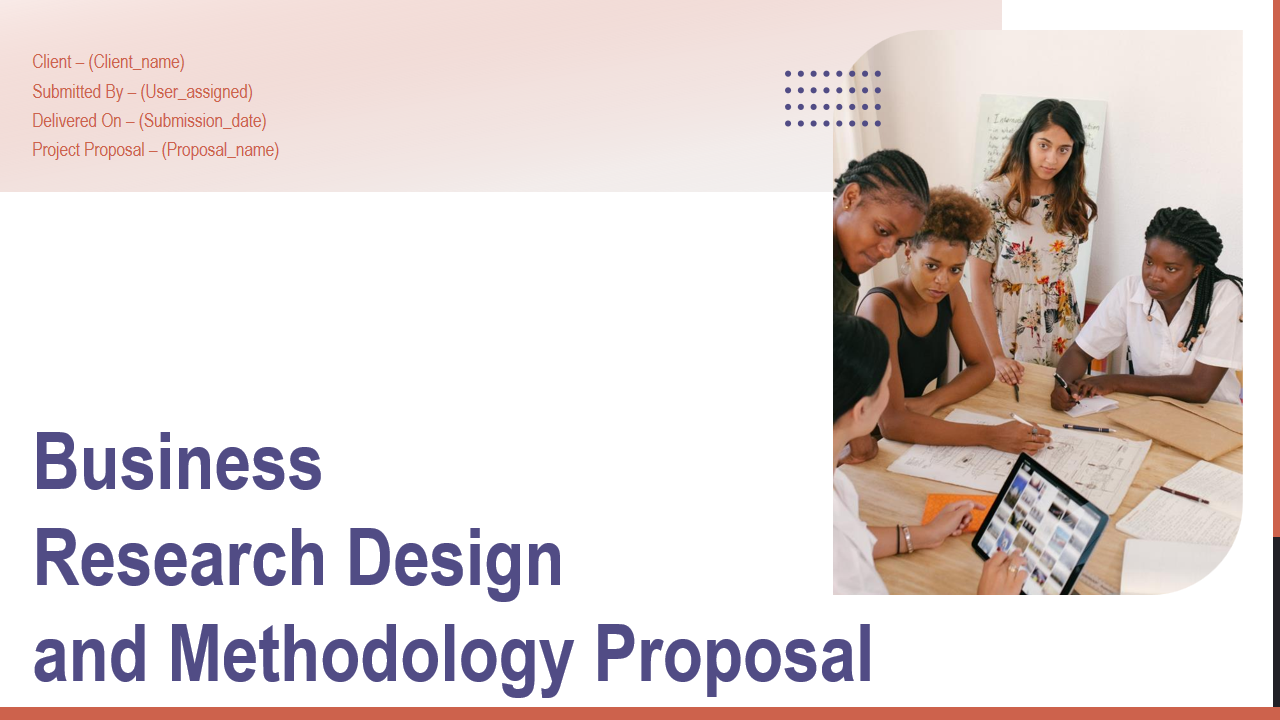
Template 4: Market Share Research Methodology Template
Wish to uncover valuable market insights? Deploy this ready-made PowerPoint template that simplifies the process of analyzing market share data, allowing you to assess your company's performance in relation to competitors. With pre-designed sections for data collection, analysis, and visualization, easily track market trends, identify growth opportunities, and make data-driven decisions. Save time and enhance your market research efforts with our market share research template, empowering you to stay ahead in a competitive business landscape.
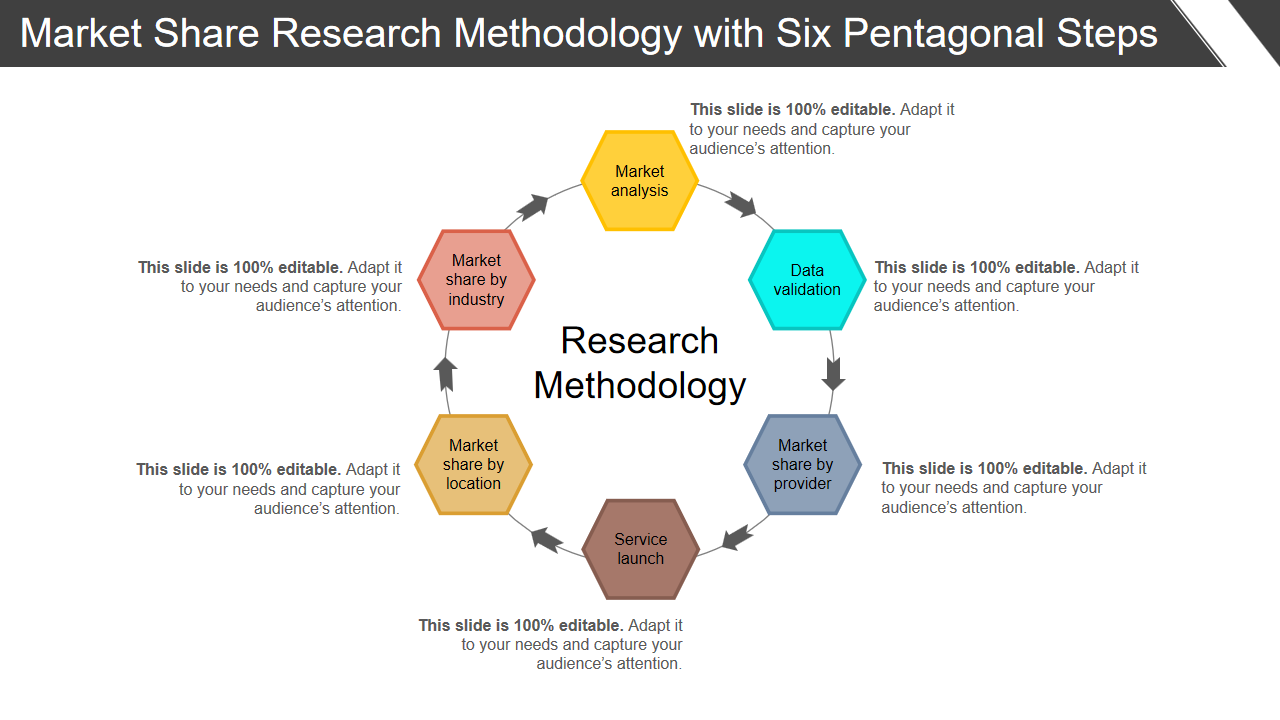
Template 5: PESTEL Analysis Research Methodology PPT Template
Gain a comprehensive understanding of your business environment with our pre-designed PESTEL analysis research methodology template. This versatile template provides a structured framework for conducting a thorough analysis of the political, economic, social, technological, environmental, and legal factors impacting your industry or market. Easily identify key trends, opportunities, and risks by utilizing our pre-designed sections and guidance. Streamline your research process and make informed strategic decisions using our PESTEL Analysis research methodology template, ensuring your business stays ahead of the curve.
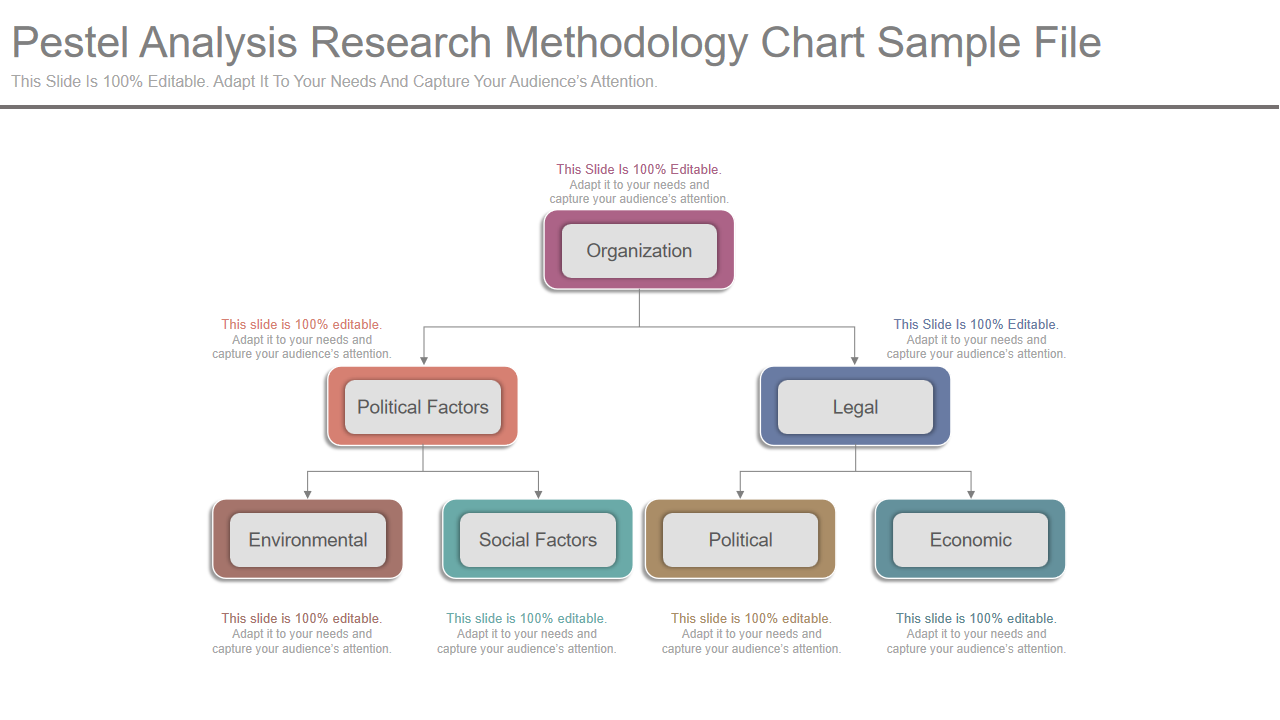
Template 6: Research Methodology with 3 Step Process Map PPT Template
Looking for ways to create a research methodology process? Achieve research success with our content-ready PPT template which simplifies the research journey into three steps. Collect data, conduct research, and evaluate your findings to draw meaningful conclusions. With our template, you'll stay organized and ensure consistency throughout your research process. Maximize your research potential and achieve impactful results using our premium PPT slide.
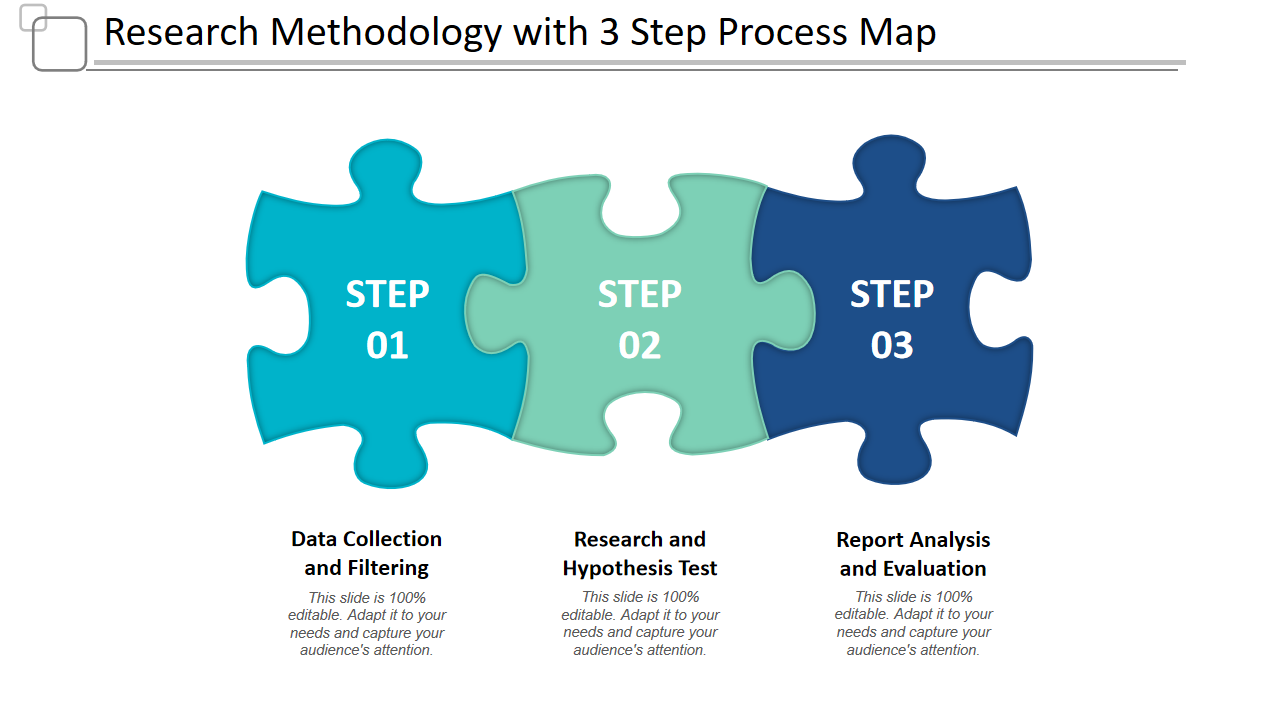
Template 7: Rational Sections Research Methodology Template
This is a well-structured PowerPoint template that features distinct sections that guide you through every aspect of your research. From clearly defining research objectives to selecting appropriate data collection methods, analyzing data, and interpreting results, this PPT slide ensures you cover all essential components. With pre-designed sections for literature review, research design, data analysis, and more, you can streamline your research process and maintain consistency. Harness the potential of each section in our research methodology template to conduct rigorous and impactful studies.
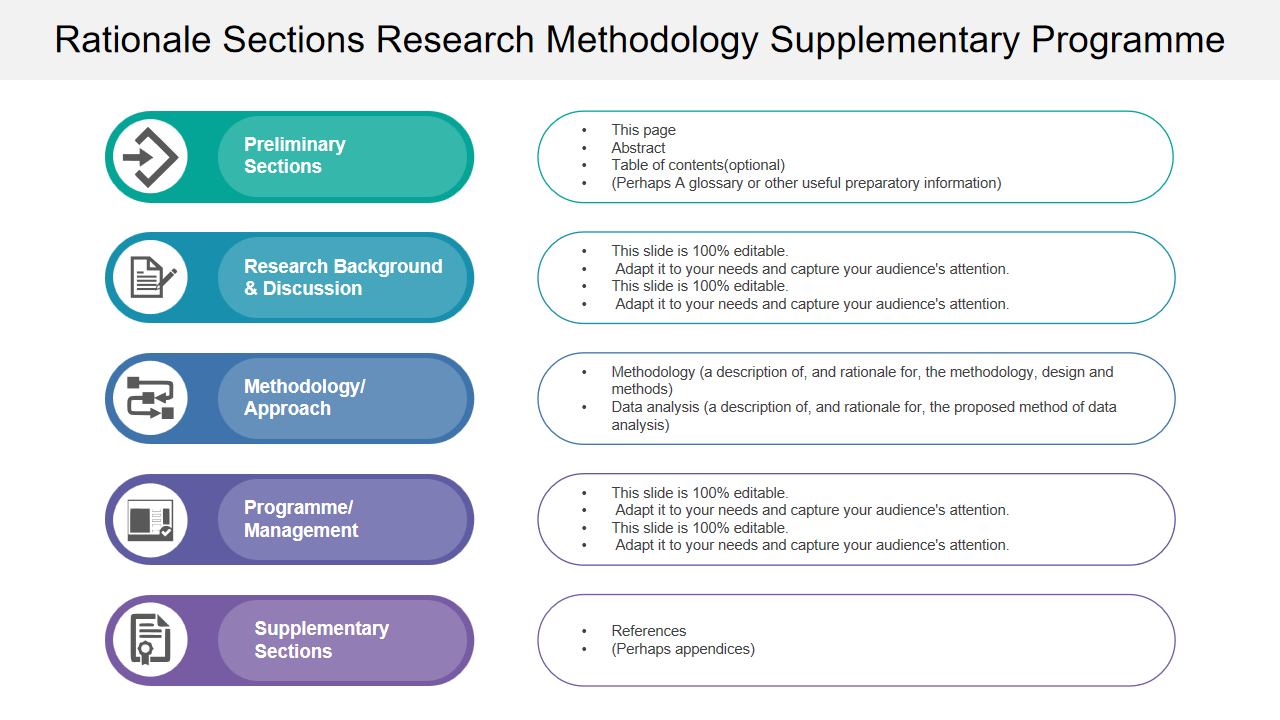
Template 8: Research Methodology with Analysis PPT Template
Unleash the power of data-driven insights with our ready-made PPT template. This all-inclusive template integrates research methodology and data analysis, providing a comprehensive framework for conducting robust studies. From defining research objectives to data collection, cleaning, and analysis, our template guides you through each step of the research process. With pre-designed sections for statistical analysis, visualizations, and interpretation, uncover meaningful patterns and trends in your data. Elevate your research endeavors with this actionable template and unlock valuable insights for informed decision-making.
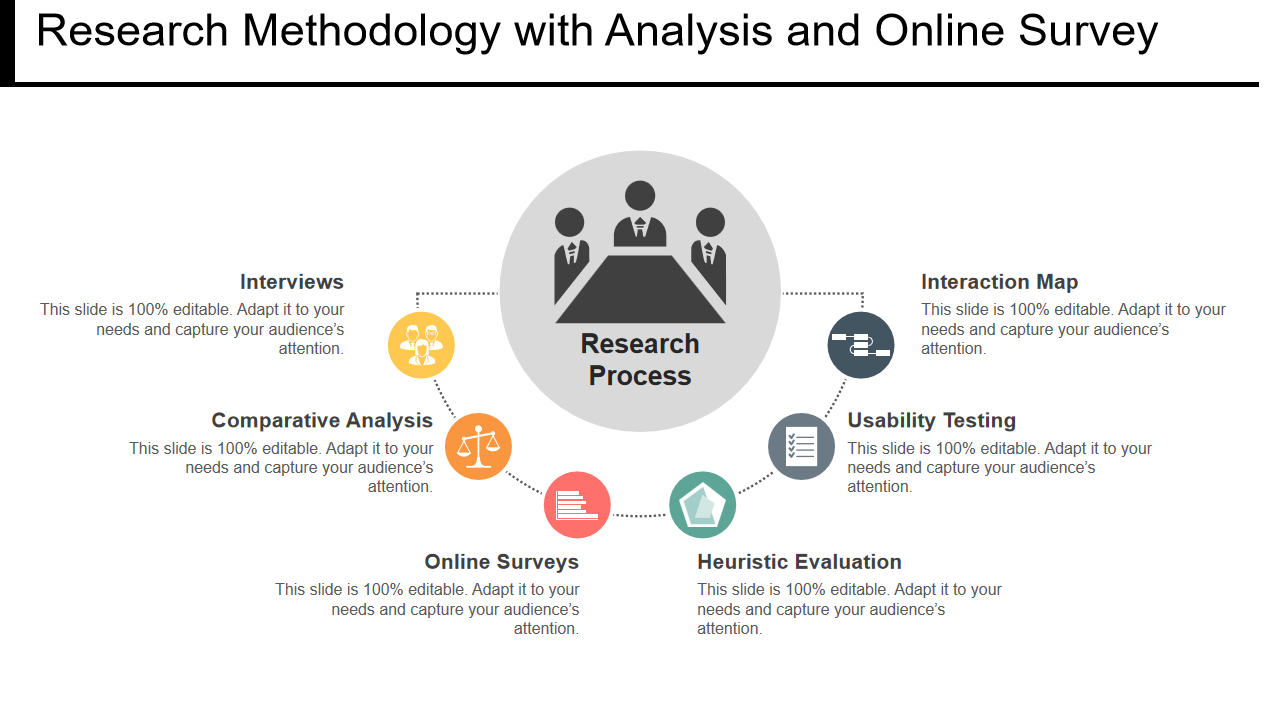
Template 9: Research Methodology Workflow PPT Template
Wish to optimize your research workflow? Use this content-ready PPT template that simplifies the process of planning, executing, and documenting your research methodology. With pre-designed sections for each stage, including research question formulation, data collection, analysis, and reporting, this pre-designed template ensures a structured and organized approach. Streamline your workflow, enhance collaboration, and maintain consistency throughout your research project with our professional and appealing PPT slide.
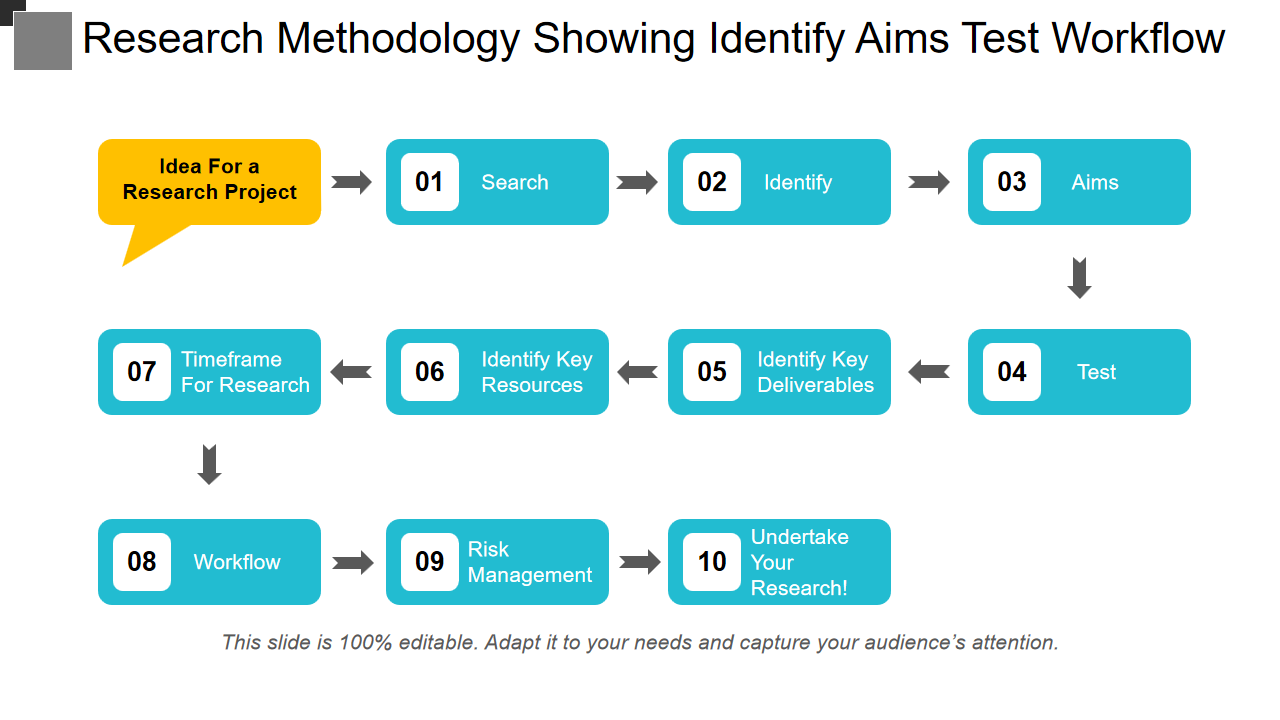
Template 10: Research Methodology with Literature Review PPT Template
Deploy this content-ready PowerPoint template to elevate your research that showcases crucial elements of literature review, providing a seamless framework for conducting rigorous investigations. With this pre-designed PPT template exhibiting research objectives, appropriate methods, a thorough literature review, and findings with existing knowledge, you can save time, maintain consistency, and produce impactful research. Leverage our PPT template to uncover valuable insights and contribute to the advancement of knowledge in your field.
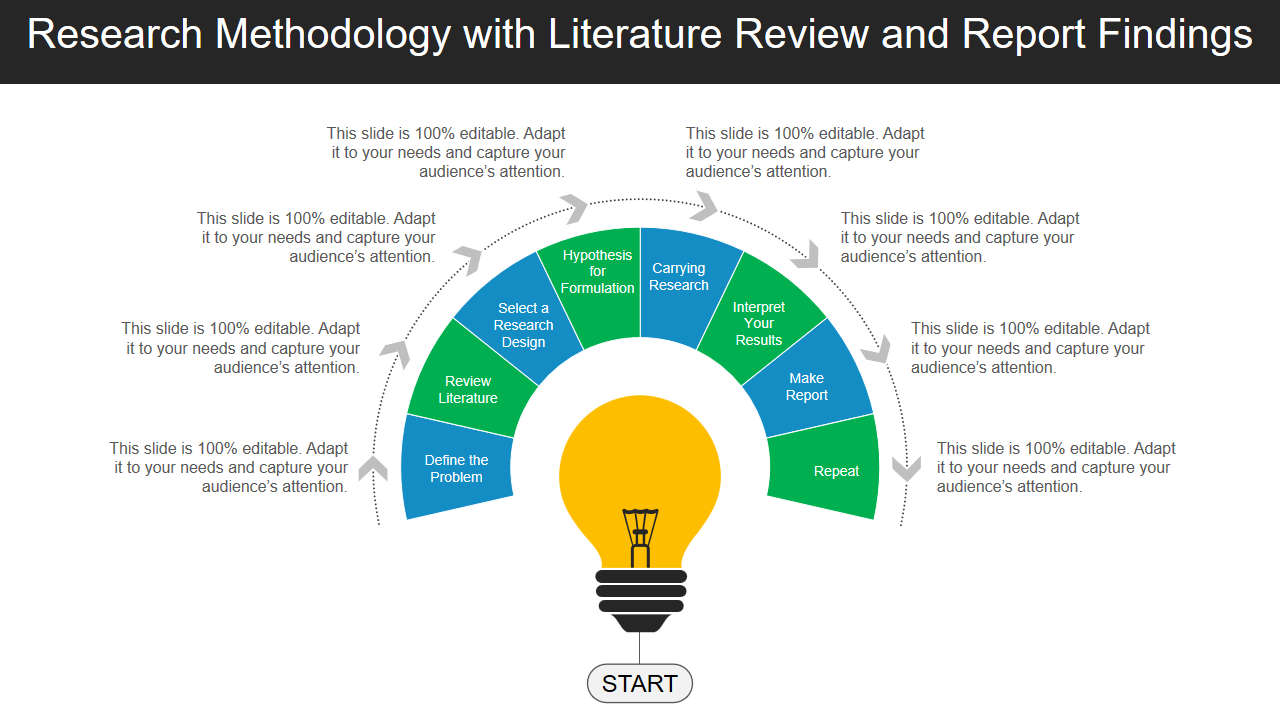
Template 11: Framework of Exploratory Research Methodology PPT Template
Embark on a journey of discovery and provide a structured framework for conducting exploratory research using our content-ready template. Delve into uncharted territories and uncover new insights by incorporating this premium template. Use this PPT slide to identify problem, data collection methods, analysis techniques, and interpretation. This PowerPoint template guides you through the exploratory research process. Unlock novel perspectives, generate hypotheses, and fuel innovation using our ready-made slide.
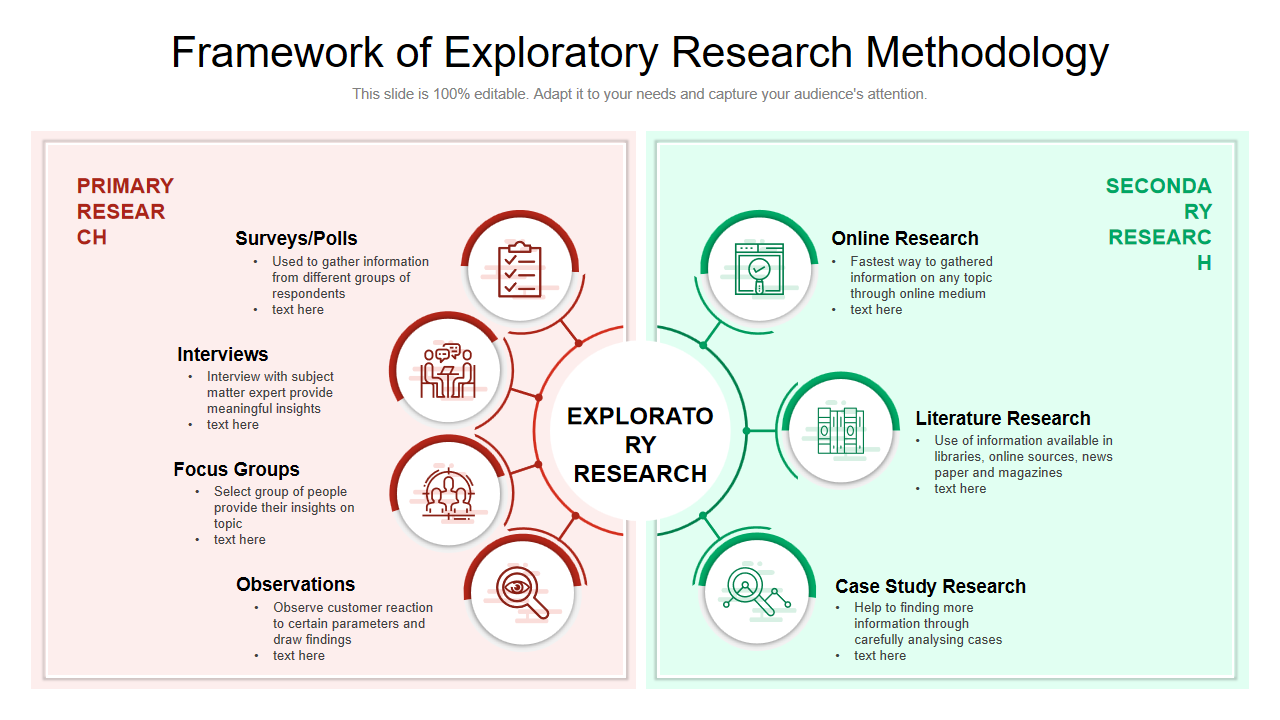
Template 12: 5 Steps Indicating Research Methodology Process PPT Template
Looking for ways to streamline your research journey? Deploy this content-ready PowerPoint template to simplify the research process into five clear and manageable steps: Define, Design, Collect, Analyze, and Report. Each step is accompanied by pre-designed sections, ensuring a systematic approach to your research project. From formulating research questions to presenting your findings, this premium template provides a structured framework for success. Save time, stay organized, and achieve research excellence with this ready-made template.
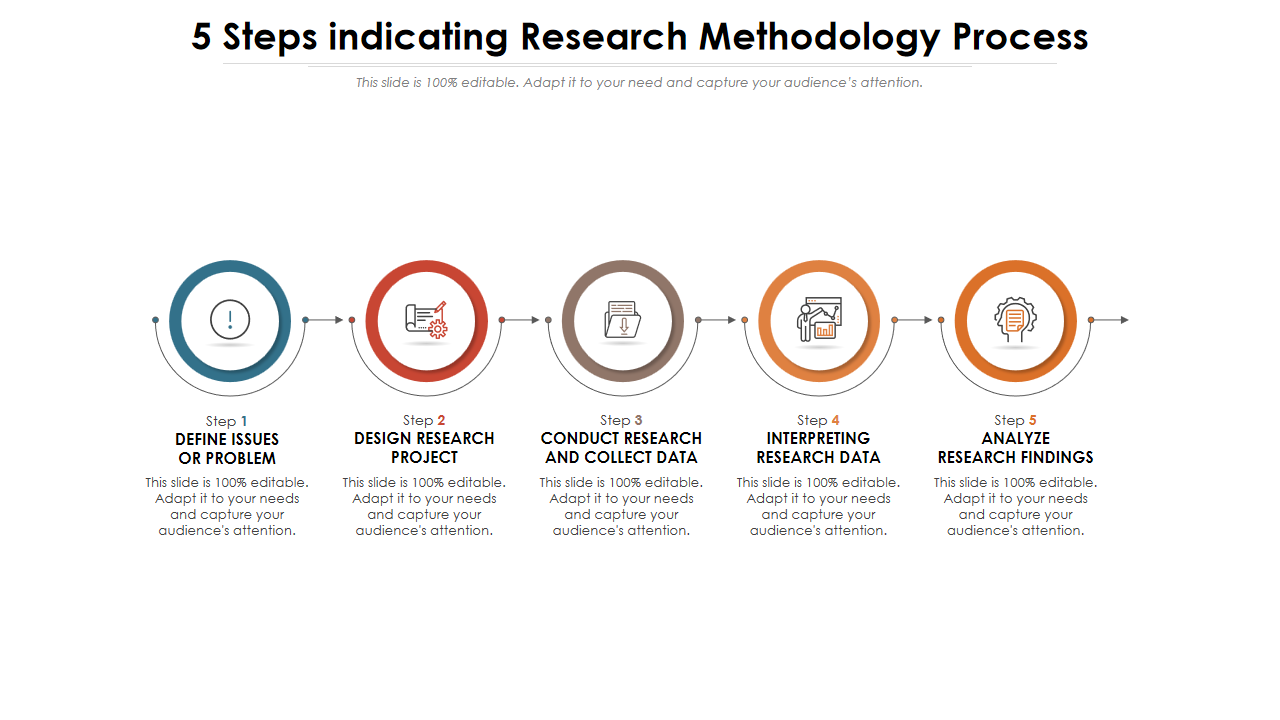
Template 13: Graph of Primary Research Methodology PPT Template
Experience the power of data-driven insights with this professional and appealing PPT template. Designed for primary research, this template offers a comprehensive framework that includes field trials, observations, interviews, focus groups, and surveys. Easily visualize and navigate through each stage of your research process, from data collection to analysis. Organize and document your findings to maximize the effectiveness of your primary research and make informed decisions using our ready to use PowerPoint template.
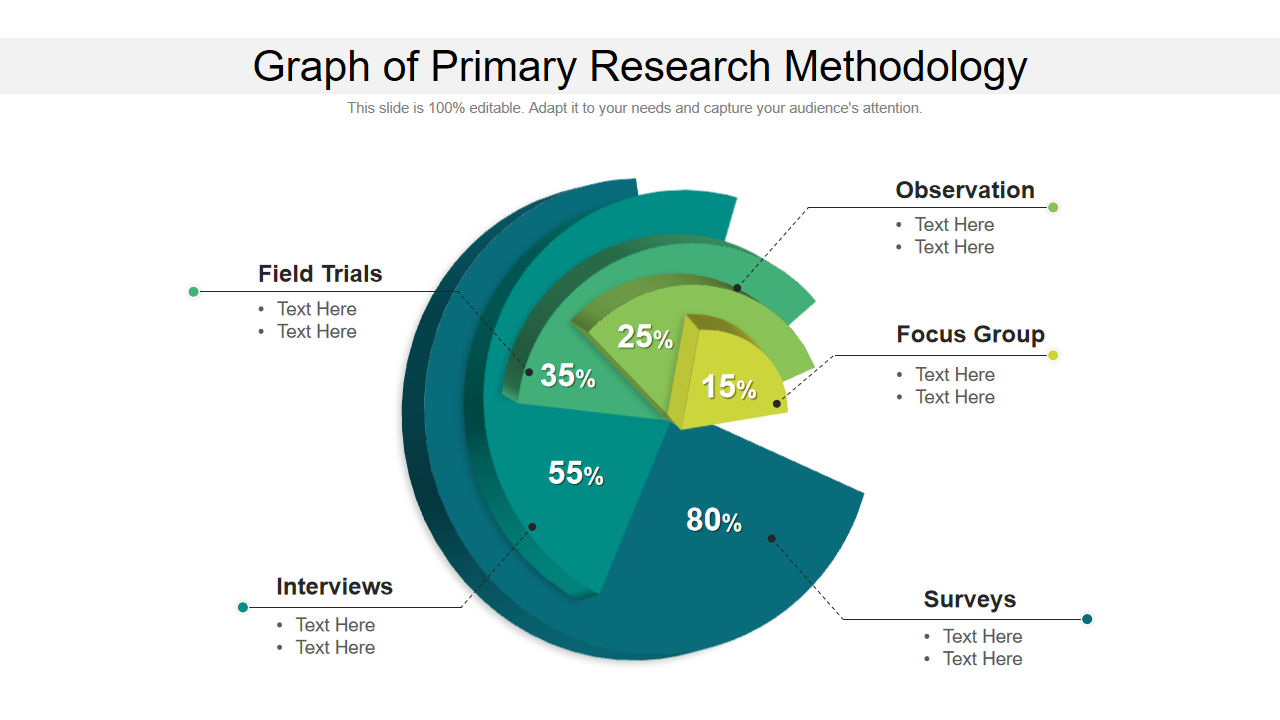
Template 14: Research Methodology Framework of Market Analysis PPT Template
Use this content-ready PPT template tailored specifically for market analysis to guide your research process. From defining research objectives to selecting appropriate data collection methods, analyzing market trends, and drawing meaningful conclusions, our template covers all essential aspects. Streamline your market analysis, maintain consistency, and make data-driven decisions with ease using our Research Methodology Framework for Market Analysis template. Stay ahead of the competition and capitalize on market opportunities.
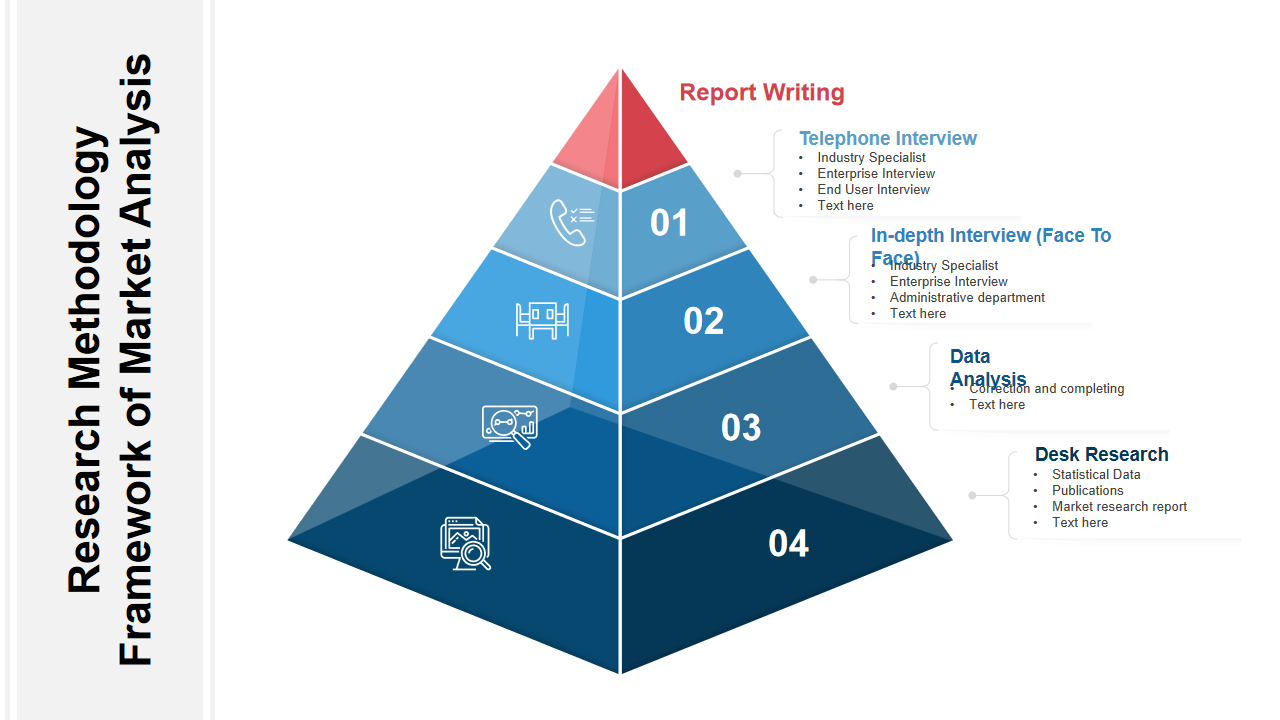

Template 15: Four Steps Process of Research Methodology PPT Template
This is a ready to use PPT template that provides you a structured and organized approach for your research methodology It includes a four-step process: Project Design, Data Acquisition, Data Analysis, and Strategy Recommendation to plan your research project, gather relevant data, analyze it using appropriate techniques, and derive actionable strategy recommendations. Save time and enhance the effectiveness of your research with our premium template, empowering you to make informed decisions and achieve impactful results.

Template 16: Market Research Methodology and Techniques PPT Template
This comprehensive template equips you with a range of methodologies and techniques to effectively study and understand your target market. From surveys and interviews to focus groups and data analysis, this premium template covers a wide array of research methods. It provides pre-designed sections for each technique, guiding you through the research process and ensuring consistency.
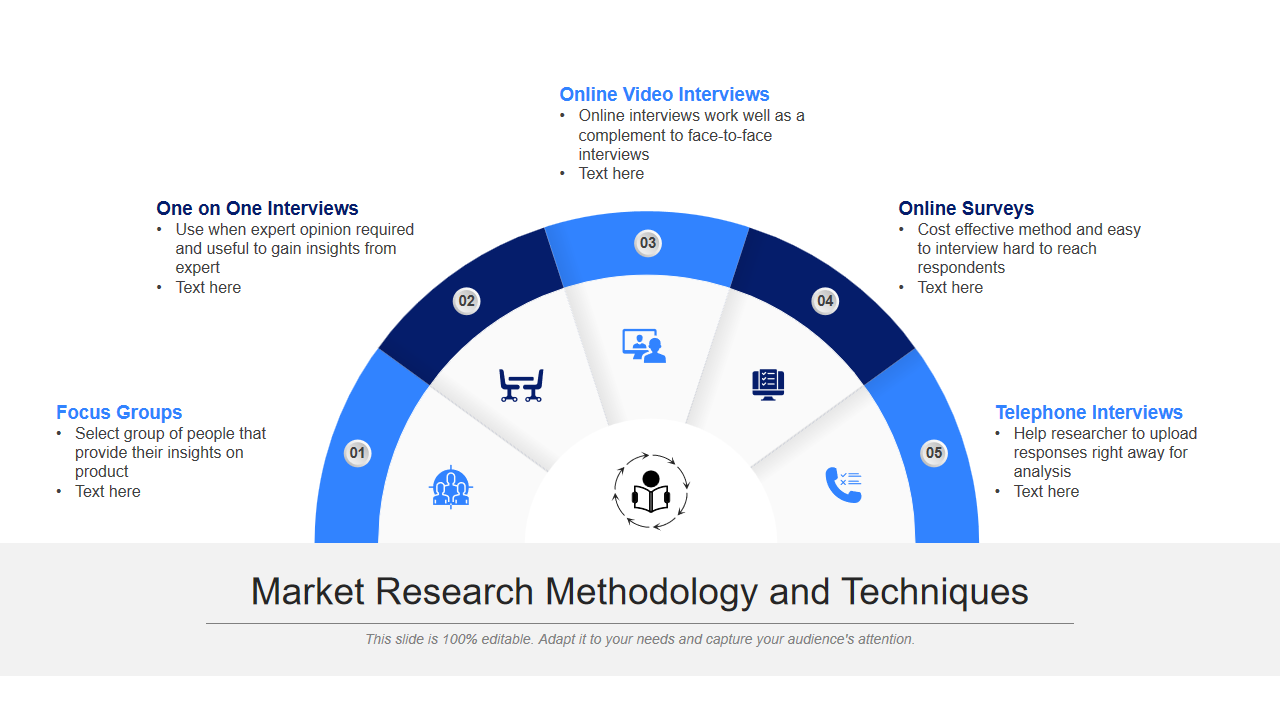
Template 17: Quantitative Market Research Methodology Framework PPT Template
This template serves as a guide to direct your market research endeavors. Showcasing each stage of the research process, including research design, data collection methods, analysis techniques, and reporting, this template ensures a systematic approach to quantitative market research. Create professional and engaging presentations, highlighting your research methodology with ease.
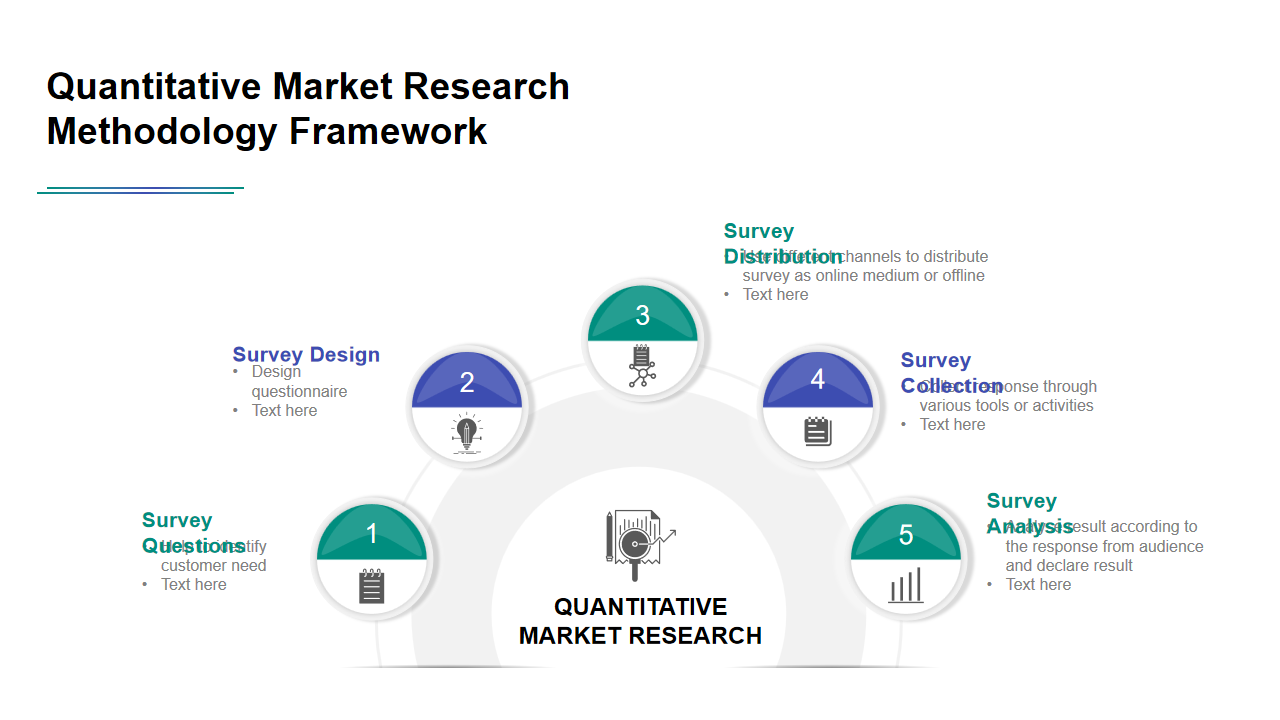
Template 18: Process Tree for Research Methodology PPT Template
Use this content-ready PPT template that outlines the sequential steps involved in conducting a research study. It serves as a roadmap, depicting the flow of activities from research question formulation to data collection, analysis, and interpretation. Like the branches of a tree, each step branches out into sub-steps and tasks, highlighting the interconnectedness and dependencies. Grab this ready-made PowerPoint template that provides you with a clear and engaging overview, ensuring researchers stay organized and follow a systematic approach throughout their research journey.
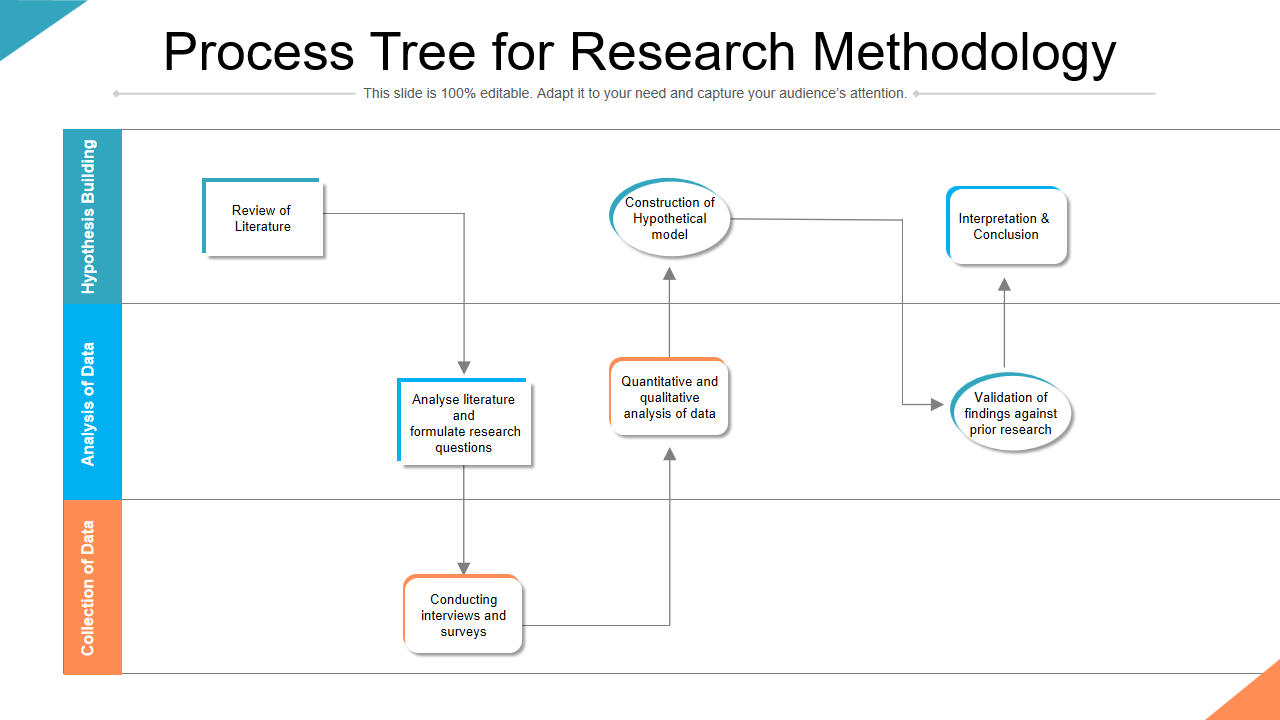
Template 19: Flowchart for Research Methodology PPT Template
Deploy this pre-designed PPT that illustrates the logical flow of steps and decisions involved in conducting a research study. Similar to a roadmap, it presents a series of interconnected boxes or shapes connected by arrows, representing the sequential progression of activities. Each box represents a specific task or process, and the arrows indicate the direction of the flow. Incorporate this PPT slide to help your audience understand the research process at a glance, making it engaging and crisp to follow the logical progression of their study.
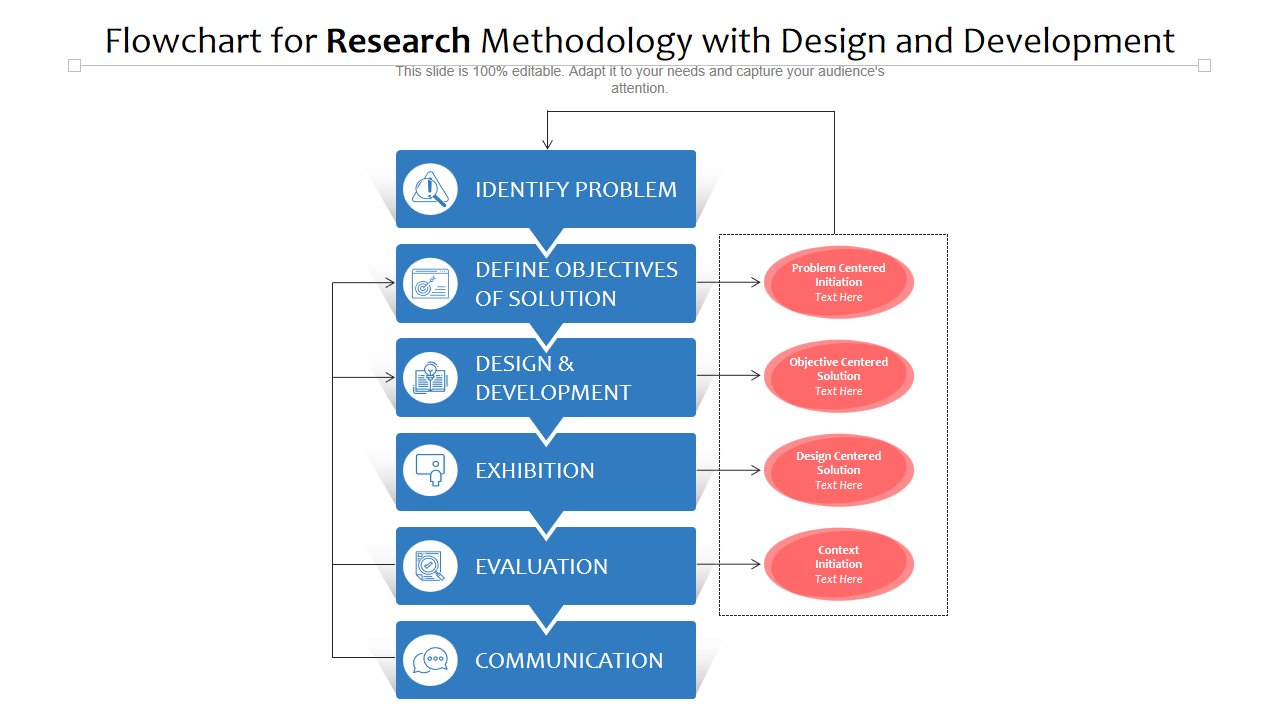
Template 20: Eleven Stage Process for Research Methodology PPT Template
Unleash the power of simplicity in research methodology using our PPT template that eliminates complexity and guides you through each step effortlessly. From defining objectives to data analysis, we've got you covered. Simplify your research journey and unlock meaningful insights with ease.
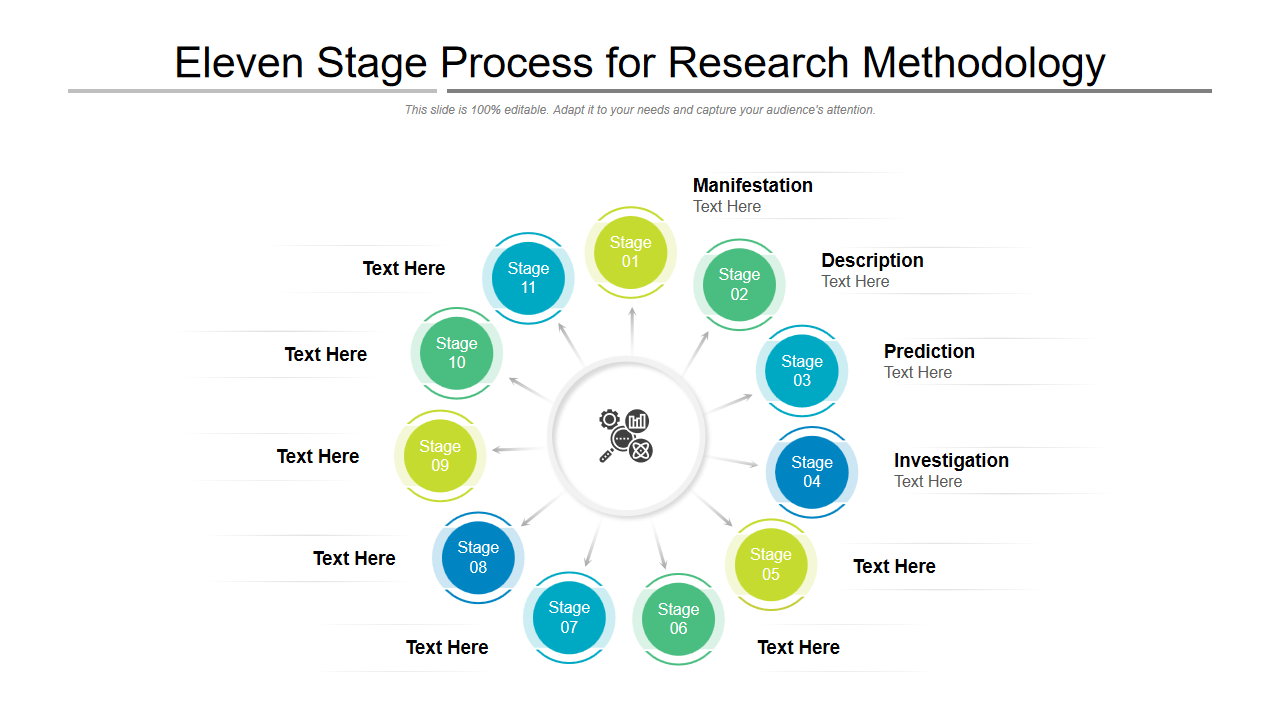
Our content-ready and custom-made templates empower researchers to streamline their work, save time, and maintain consistency. With its comprehensive structure and pre-designed sections, it simplifies the research process, ensuring all essential components are covered. Maximize your research potential and achieve impactful results with our user-friendly template.
Download now!
FAQs on Research Methodology
What are the four types of research methodology.
The four types of research methodology commonly used in academic and scientific studies are:
Descriptive Research: This type aims to describe and document the characteristics, behavior, and phenomena of a particular subject or population. It focuses on gathering information and providing an accurate portrayal of the research topic.
Experimental Research: This approach involves the manipulation and control of variables to establish cause-and-effect relationships. It often includes the use of control groups and random assignment to test hypotheses and draw conclusions.
Correlational Research: This methodology examines the statistical relationship between two or more variables without direct manipulation. It aims to identify patterns and associations between variables to understand their degree of relationship.
Qualitative Research: This approach focuses on exploring and understanding the subjective experiences, perspectives, and meanings attributed by individuals or groups. It involves methods such as interviews, observations, and analysis of textual or visual data to uncover insights and interpretations.
What are the 3 main methodological types of research?
The three main methodological types of research are:
Quantitative Research: This approach involves the collection and analysis of numerical data to uncover patterns, relationships, and statistical trends. It focuses on objective measurements, often utilizing surveys, experiments, and statistical analysis to quantify and generalize findings.
Qualitative Research: This methodology aims to understand the subjective experiences, meanings, and social contexts associated with a research topic. It relies on non-numerical data, such as interviews, observations, and textual analysis, to explore in-depth perspectives, motivations, and behavior.
Mixed-Methods Research: This type of research integrates both quantitative and qualitative approaches, combining the strengths of both methodologies. It involves collecting and analyzing both numerical and non-numerical data to gain a comprehensive understanding of the research problem. Mixed-methods research can provide a more nuanced picture by capturing both statistical trends and rich contextual information.
What are the 7 basic research methods?
There are several research methods commonly used in academic and scientific studies. While the specific categorization may vary, here are seven basic research methods:
Experimental Research: Involves controlled manipulation of variables to establish cause-and-effect relationships.
Survey Research: Utilizes questionnaires or interviews to collect data from a sample population to gather insights and opinions.
Observational Research: Involves systematic observation of subjects in their natural environment to gather qualitative or quantitative data.
Case Study Research: In-depth analysis of a particular individual, group, or phenomenon to gain insights and generate detailed descriptions.
Correlational Research: Examines the statistical relationship between variables to identify patterns and associations.
Qualitative Research: Focuses on understanding subjective experiences, meanings, and social contexts through interviews, observations, and textual analysis.
Action Research: Involves collaboration between researchers and participants to address real-world problems and generate practical solutions.
Related posts:
- 10 Most Impactful Ways of Writing a Research Proposal: Examples and Sample Templates (Free PDF Attached)
- Must-have Marketing Research Proposal Example Templates with Samples
- How Financial Management Templates Can Make a Money Master Out of You
- [Updated 2023] Top 10 Winning Case Study Competition Presentations [and 10 Vexing Business Issues They Can Help You Solve]
Liked this blog? Please recommend us

Top 15 System Development Life Cycle Templates to Build Robust Business Applications

Top 15 Matrix Management Templates to Boost Collaboration
This form is protected by reCAPTCHA - the Google Privacy Policy and Terms of Service apply.

Digital revolution powerpoint presentation slides

Sales funnel results presentation layouts
3d men joinning circular jigsaw puzzles ppt graphics icons

Business Strategic Planning Template For Organizations Powerpoint Presentation Slides

Future plan powerpoint template slide

Project Management Team Powerpoint Presentation Slides

Brand marketing powerpoint presentation slides

Launching a new service powerpoint presentation with slides go to market

Agenda powerpoint slide show

Four key metrics donut chart with percentage

Engineering and technology ppt inspiration example introduction continuous process improvement

Meet our team representing in circular format

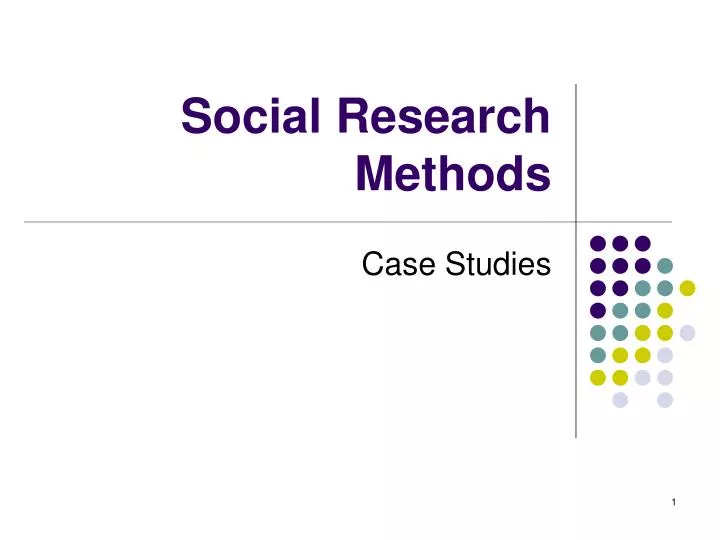
Social Research Methods
Sep 11, 2014
210 likes | 1.6k Views
Social Research Methods. Case Studies. What is a Case Study?. “ A strategy for doing research which involves an empirical investigation of a particular contemporary phenomenon within its real life context using multiple sources of evidence ” (Robson, 1993, p. 146) A Case Study may be…
Share Presentation
- case studies
- replication strategy
- individual case study
- case study research designs

Presentation Transcript
Social Research Methods Case Studies
What is a Case Study? • “A strategy for doing research which involves an empirical investigation of a particular contemporary phenomenon within its real life context using multiple sources of evidence” (Robson, 1993, p. 146) • A Case Study may be… • Descriptive • Exploratory • Explanatory • Focussed on • Process - how was it done? • Outcome - does it work?
Types of Case Study • Individual Case Study • Stanley, the ‘jack-roller’ - Shaw. • Set of individual case studies • Three general practice surgeries compared • Community Studies • Family and Kinship in East London, The Azande in the Sudan • Social Group Studies • Outsiders - Becker on Marijuana smokers and musicians • Studies of organizations and institutions • Working for Ford - Benyon; National Front - Fielding • Studies of events, roles and relationships • Housewife - Oakley; Cuban Missile Crisis
How to plan a case study Think about… • Conceptual Framework • Research Questions • Research Design • Sampling/replication strategy • Methods and Instruments • Analysis of Data
Conceptual Framework • Displays the important features of a case study • Shows relationships between features • Makes assumptions explicit • Selective • Iterative • Based on theory • Takes account of previous research • Includes personal orientation • Includes overlaps and inconsistencies
Research Questions • Consistent with conceptual framework • Covers conceptual framework thoroughly • Structured and focussed • Answerable • Forms basis for data collection
Basic Types of Case Study Design Shaded cells are case study research designs From Gerring, John (2007) Case Study Research. Cambridge: Cambridge University Press. p. 28.
Replication Strategy (sometimes called sampling strategy) Literal vs. theoretical replications • Literal = more of the same • Theoretical = different, identified according to a theoretical standpoint. • Must be linked to research questions • Determines the extent to which generalisation is possible (N.B. Theoretical not statistical generalisation.)
Theoretical Replication Choose: • Actors • E.g. Men and women, MEPs from different countries, members of different pressure groups • Settings • E.g. different companies, different branches of political party, range of local authorities. • Events • E.g. Elections, selection meetings, budget group meetings, demonstrations. • Processes • E.g. Negotiating new laws, developing media strategies.
Why select a single case? • Critical case (test case) • Theory well developed. Case will confirm or refute theory. E.g. Festinger et al. When Prophesy Fails • Extreme or unique case • Common in clinical cases. E.g. Fielding - National Front • Representative or typical case • Capture the circumstances of the everyday. E.g. Lynd & Lynd - Middletown study.
Methods and Instruments • Observation • Participant observation • Ethnography • Systematic observation • Interview • Open-ended • Focussed/semi-structured • Structured • Documents/Records E.g. minutes of meetings, patient records, diaries… • Etc.
Analysis of Data • Prepare (lots of data) • May start during data collection • How will the data be organised? • What analysis strategy will you use? • Follow theoretical propositions • Develop descriptive framework
Problems for Validity • Unreliable self-report data • Unsubstantiated observations • Post-hoc, unsystematic summaries • Speculation and overgeneralization
Common pitfalls • Token literature review • Premature theorizing • Phase slippage
- More by User
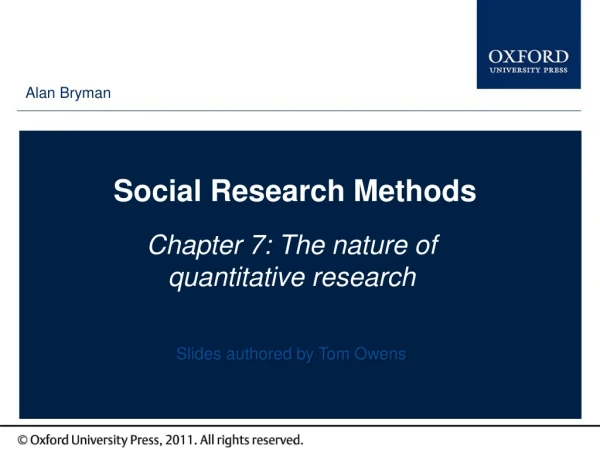
Alan Bryman. Social Research Methods. Chapter 7: The nature of quantitative research. Slides authored by Tom Owens. Concepts are: Building blocks of theory Labels that we give to elements of the social world Categories for the organization of ideas and observations (Bulmer , 1984 )
765 views • 15 slides

Social Research Methods. observation. Why would you use observation?. Covert observation. Non-Participant observation. Participant observation. Overt observation. Participant Observation. Researcher joining in with the group or community they are studying.
1.2k views • 24 slides

Social Research Methods. The Research Process and the Quality of Research. Shipman ’ s 4 key questions about the quality of research. (Shipman (1988) The Limitations of Social Research )
660 views • 12 slides

Alan Bryman. Social Research Methods. Chapter 10: Self-completion questionnaires. Slides authored by Tom Owens. Also called a self-administered questionnaire No interviewer present Respondent writes answers on form Returned to researcher or deposited for collection
750 views • 15 slides

Alan Bryman. Social Research Methods. Chapter 11: Asking questions. Slides authored by Tom Owens. Advantages Respondents answer in their own terms Allow for new, unexpected responses Exploratory - generate fixed answer questions Disadvantages Time-consuming for interviewer and respondent
1.02k views • 11 slides

Alan Bryman. Social Research Methods. Chapter 8: Sampling. Slides authored by Tom Owens. Survey elements. Page 186. Population: the universe of units from which the sample is to be selected Sample: the segment of population that is selected for investigation
777 views • 20 slides

Alan Bryman. Social Research Methods. Chapter 21: Focus groups. Slides authored by Tom Owens. Form of group interview Several participants and a moderator Individuals in a social context Discussion of specific issue Study interaction between group members
508 views • 13 slides

Alan Bryman. Social Research Methods. Chapter 5: Reviewing the literature. Slides authored by Tom Owens. Once you have identified your research questions (see Chapter 4), the next step in any research project is to search the existing literature and write a literature review.
511 views • 27 slides

283 views • 20 slides

Alan Bryman. Social Research Methods. Chapter 26: Breaking down the quantitative/qualitative divide. Slides authored by Tom Owens. Distinction between quantitative and qualitative research remains useful
265 views • 15 slides

Alan Bryman. Social Research Methods. Chapter 17: The nature of qualitative research. Slides authored by Tom Owens. Inductive view of relationship between theory and research theories and concepts emerge from the data Interpretivist epistemology Constructionist ontology
694 views • 19 slides

Alan Bryman. Social Research Methods. Chapter 3: Research designs. Slides authored by Tom Owens. A Research Design provides a framework for the collection and analysis of data. Choice of research design reflects decisions about priorities given to the dimensions of the research process.
851 views • 24 slides

Alan Bryman. Social Research Methods. Chapter 20: Interviewing in qualitative research. Slides authored by Tom Owens. Qualitative interviews… are less structured/standardized take the participant’s viewpoint encourage ‘rambling’ off the topic are more flexible seek rich, detailed answers
657 views • 15 slides

Social Research Methods. Surveys. Survey. Characteristics Collecting a SMALL amount of data in STANDARDISED form from RELATIVELY LARGE NUMBERS OF INDIVIDUALS Selection of REPRESENTATIVE SAMPLES of individuals from KNOWN POPULATIONS. Surveys are very common.
304 views • 22 slides

Social Research Methods. Social Research. Goal : Test common sense & peoples assumptions then replace with fact & evidence and make…………. Generalizations!!. Definition : statement about a group of people or things that is based on only a few people or things in that group.
361 views • 19 slides

Social Research Methods. Experiments. Experiments. One of the three research strategies: Experiment Survey Case Study. Experimental Design. Assignment of subjects to different conditions (N.B. subject or participant or respondent)
337 views • 27 slides

Alan Bryman. Social Research Methods. Chapter 23: Documents as sources of data. Slides authored by Tom Owens. These are ‘documents’ that….. can be read (but not just text – visuals as well!) have not been produced specifically for the purposes of research
321 views • 15 slides

Alan Bryman. Social Research Methods. Chapter 2: Social research strategies. Slides authored by Tom Owens. Student experience. A valuable feature of the text is the ‘Student experience’ boxes with links to the Online Resource Centre. page 20. Theory and research. What type of theory?
440 views • 25 slides

Alan Bryman. Social Research Methods. Chapter 24: Qualitative data analysis. Slides authored by Tom Owens. General strategies: analytic induction grounded theory Coding: steps considerations problems. Qualitative data analysis. Page 565.
340 views • 18 slides
Got any suggestions?
We want to hear from you! Send us a message and help improve Slidesgo
Top searches
Trending searches

teacher appreciation
11 templates

islamic history
36 templates

27 templates

memorial day
12 templates

55 templates
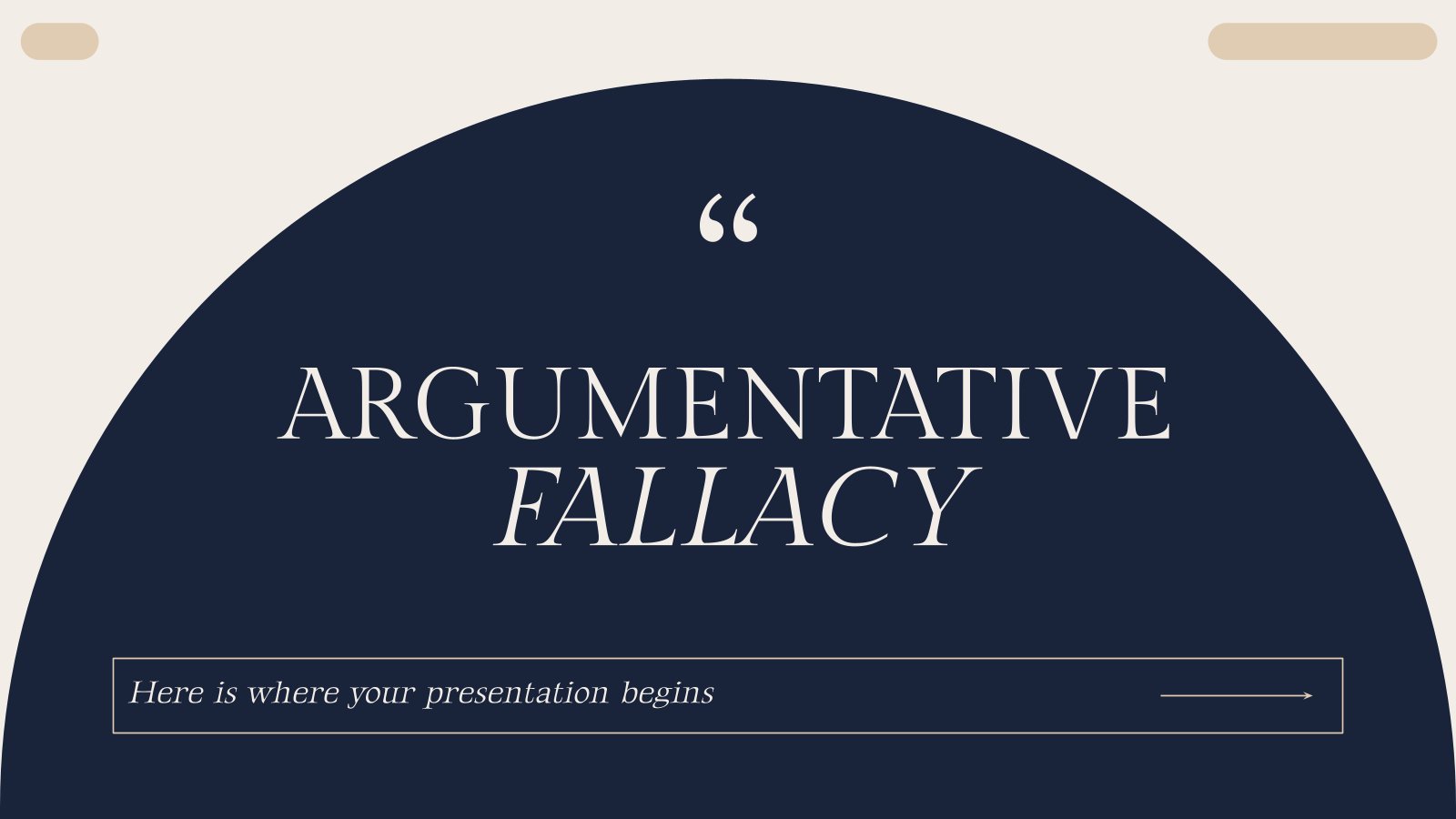
104 templates
Research Methods Lesson
Research methods lesson presentation, premium google slides theme, powerpoint template, and canva presentation template.
If you deal with Science, it’s important to learn more about research methods. Teach your students about them with this presentation full of illustrations and drawings related to labs. Use graphs, maps, tables and overview diagrams to support your lecture in a visual way!
Features of this template
- A formal design that is perfect for research or Chemistry lessons
- 100% editable and easy to modify
- 28 different slides to impress your audience
- Available in five colors: cream, green, pink, blue and yellow
- Contains easy-to-edit graphics such as tables, charts, diagrams and maps
- Includes 500+ icons and Flaticon’s extension for customizing your slides
- Designed to be used in Google Slides, Canva, and Microsoft PowerPoint
- 16:9 widescreen format suitable for all types of screens
- Includes information about fonts, colors, and credits of the free resources used
What are the benefits of having a Premium account?
What Premium plans do you have?
What can I do to have unlimited downloads?
Combines with:
This template can be combined with this other one to create the perfect presentation:

Don’t want to attribute Slidesgo?
Gain access to over 23400 templates & presentations with premium from 1.67€/month.
Are you already Premium? Log in
Available colors
Original Color
Related posts on our blog

How to Add, Duplicate, Move, Delete or Hide Slides in Google Slides

How to Change Layouts in PowerPoint

How to Change the Slide Size in Google Slides
Related presentations.

Premium template
Unlock this template and gain unlimited access

Register for free and start editing online

IMAGES
VIDEO
COMMENTS
2. Learning Objectives By the end of this presentation you will able to: 1-Define and explain the concept of scientific research, deduction and induction reasoning , theory, hypothesis and empiricism. 2- Clarify the Sources of knowledge/truth 3 - Identify and explain the features and application of different categories and sub- categories of research methods 4- Characteristics of good topic. 5 ...
This guide will. Introduce you to a range of research methods. Help you think about the value and limitations of different research methods. Identify when to use alternative research methods. You should use the guide. After or while you establish your research questions (See the Guide to Research Questions) When you are completing your Research ...
New York: Prentice-Hall, 1960. Download ppt "Lecture Notes on Research Methodology". 1 Research Methodology: An Introduction: MEANING OF RESEARCH: Research in common parlance refers to a search for knowledge. Once can also define research as a scientific & systematic search for pertinent information on a specific topic.
A COURSE IN RESEARCH METHODOLOGY 2018.pptx. This teaching paper is an introdcution to the field of research methodology as it enables beginners (students) to understand basic things about research, research techniques , research design and research procedure. The general aim behind this teaching paper is to facilitate the task of students to ...
Findings from qualitative research are inextricably tied up with the way those findings are presented. These presentations do not always need to be in writing, but they need to happen. Think of ethnographies, for example, and their thick descriptions of a particular culture. Witnessing a culture, taking fieldnotes, talking to people—none of ...
Turning a research paper into a visual presentation is difficult; there are pitfalls, and navigating the path to a brief, informative presentation takes time and practice. As a TA for GEO/WRI 201: Methods in Data Analysis & Scientific Writing this past fall, I saw how this process works from an instructor's standpoint.
Presentation Transcript. Research methods and techniques. Perfecto Herrera. Research approaches • Observational studies: we observe and code a given behaviour, then try to elaborate possible explanations (e.g., amount and duration of ocular contact between the members of a quartet) • We can develop hypotheses to be experimentally tested ...
The document provides an introduction to research methodology. It begins with definitions of research and discusses the objectives, characteristics, criteria and qualities of good research. It also covers different types of research such as descriptive vs analytical and quantitative vs qualitative. The document outlines various sections that will be covered in more depth including research ...
Step 1: Consider your aims and approach. Step 2: Choose a type of research design. Step 3: Identify your population and sampling method. Step 4: Choose your data collection methods. Step 5: Plan your data collection procedures. Step 6: Decide on your data analysis strategies. Other interesting articles.
Research methods are specific procedures for collecting and analyzing data. Developing your research methods is an integral part of your research design. When planning your methods, there are two key decisions you will make. First, decide how you will collect data. Your methods depend on what type of data you need to answer your research question:
The backbone of any scientific inquiry: the methodology. A systematic process of collecting, analyzing, and interpreting data to draw conclusions about a particular subject matter. However, many researchers struggle with selecting the appropriate research design, sampling methods, data collection, and analysis techniques. But your workshop is ...
Template 16: Market Research Methodology and Techniques PPT Template This comprehensive template equips you with a range of methodologies and techniques to effectively study and understand your target market. From surveys and interviews to focus groups and data analysis, this premium template covers a wide array of research methods.
Presentation Transcript. Methods and Techniques of Research: An Introduction of the Course Program for Thesis Writing. Definition of Research: • Research is "a process of scientific thinking that leads to the discovery or establishment of new knowledge or truth. • It is not a subjective expression of ideas or opinion.".
Experimental and Survey Research. (D) On the basis of method of research: On the basis of research method we may classify a research into five different categories. (i) Philosophical Research: It is purely qualitative in nature and we are focusing on the vision of others on the content of research.
This is a market research methods diagram ppt slides show. This is a nine stage process. The stages in this process are research approach, research source, research method, primary, society group individuals, survey focus group, secondary, library web database archive, literature review. Slide 1 of 7.
Presentation Transcript. Social Research Methods Case Studies. What is a Case Study? • "A strategy for doing research which involves an empirical investigation of a particular contemporary phenomenon within its real life context using multiple sources of evidence" (Robson, 1993, p. 146) • A Case Study may be….
Premium Google Slides theme, PowerPoint template, and Canva presentation template. If you deal with Science, it's important to learn more about research methods. Teach your students about them with this presentation full of illustrations and drawings related to labs. Use graphs, maps, tables and overview diagrams to support your lecture in a ...
Title: Optimizing the computational modeling of traumatic brain injury with machine learning and large animal modeling Abstract: Legislation across all 50 states in the U.S. addresses sports-related mild traumatic brain injury (mTBI), requiring medical clearance before students can return to play. However, there currently lacks an objective, unbiased method to pre-screen potential mTBI ...
Online estimation techniques are extensively used to determine the parameters of various uncertain dynamic systems. In this paper, online estimation of the open-circuit voltage (OCV) of lithium ...